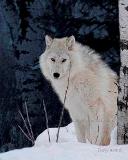|
The following written years ago
for my guide are copyright to WEV.
1) What is the difference between a dog and wolf?
A: Though a wolf is not a dog, a dog is considered a domesticated wolf.
There are no known behaviors found in wolves that cannot also be found in domestic dogs what may differ is the frequency,
intensity and in the context in which the behavior is expressed. Those differences
expressed can also differ depending on the breed and or breed type of dog. You can say through the domestication process
the behaviors have been watered down in domestic dogs, in some breeds more than
others. Some traits found in wolves and to some degree dogs as well are of the following.
Prey Driven: All
canines are predators and have a certain degree of prey drive, some much more than others depending on the type of canine. Prey Drive: meaning they will give chase to things that run, for example small animals. Once this drive(predatory/prey drive) is triggered via fast movement and the wolf gives chase, what once may
have started out as only a chase initially
can fast become a situation where the object becomes something to then kill.
Wolves, were built to be efficient predators and survivors, this predatorial instinct and drive is WELL developed
and extremely strong/intense. Which is but one reason wolves are not pets!
Dominancy issues: In the wild
wolves have a hierarchy and each one has a rank, each wolf has the instinct, drive, and incentive to climb the social ladder
of rank. Meaning they will eventually want to become the dominant leader in the pack, not every wolf however manages to do
this and a more dominant alpha leader may thwart attempts by a subordinate wolf.
This does not mean the current dominating leader cannot and is not challenged, and even taken out permanently
(killed) or driven out, by other subordinate wolves once they no longer are strong enough to maintain their alpha leader status. *Wolves will continuously
test each other starting as young puppies,and this continues throughout their lives. What may look like play
to us, may be in all actuality a test of leadership, or weakness.* (klinghammer)
| Female Wolf Asserting Dominance over young male |
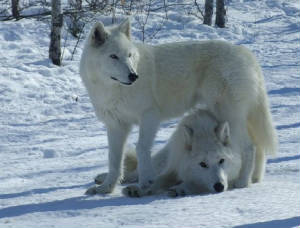
|
Shyness: Wolves in the wild are inherently shy creatures, this
will serve to help keep them safe from potential dangers such as hunters in the wild. After around 14-16 weeks
the window of opportunity for a pups socialization to others
is already starting to close. Meaning anything they come upon not socialized to
prior they become wary of and shy away from. In captive situations to help with this issue, and so that wolves are
comfortable in a captive situation and not stressed, pups are socialized to as many people as is possible such as veterinarians,
young people, old people, doorways, umbrellas, different clothing such as winter jackets and mittens, hats, tractors, and
other machinery, etc, otherwise the pups as adults will view such things as something to be suspicious of, and may even freak
out in fear over.
Diggers: Wolves like to dig, they can dig holes so deep that a 6 foot tall man can completely disappear. Wolves typically will dig for
a few different reasons
a) to create dens for pups
to be born in the spring
b) To dig to keep cool in the
hot summer months, the colder earth serves as a sort of air conditioning.
c) *digging up roots/shrubs,mice/voles/rabbits
they may smell
d) digging out of boredom
Territorial: In
the wild wolves are highly territorial for good reason; it is a hard life and resources (food, mating rights of females) become
a competition. Wolves will thus drive out even kill other wolves or stray roaming dogs infringing upon their marked territories. Contrary
to popular belief that wild wolves mate with free ranging dogs, most dogs will be viewed as either a meal or enemy trespassing
to be killed.
Destructiveness: Having
raised quite a few wolves over the years from infancy to adulthood in captive situations, has given me a first hand seat
into their true destructive natures. Wolves are soo intelligent ,and sooo curious they like to take things
literally apart to see how they work. By the time pups are approx. 3 monthsof age they are destroying anything and everything
they can get their paws and teeth on, and they are ready to be placed outside. You cannot train this behavior out of
a wolf pup like owners do with domestic dogs, and it would be wrong to try to. In the wild parents and the other
family members *adults* within the pack allow the pups to explore and experience, they are allowed to grab anything they want
and chew it up if they want to. Pups are allowed to get away with a LOT, a LOT more than any domestic dog pup is allowed to in a domestic living environment, this is apart of growing up as a wolf, and
is completely normal behavior. Everything a wolf does is with intensity and exaggeration.
Howling:
Wolves love to howl, they howl to reunite their pack members when separated, they howl when mourning the loss of a
pack member, they howl when excited, they howl prior to a hunt and after eating in bonding sessions, they howl to alert other
wolves (wolf packs) they are in the area, and they howl just because they feel like it. I am sure there are reasons wolvs
howl, that humans are not even aware of.
| Pure wolf dharma |
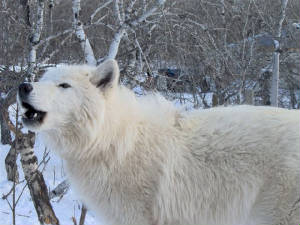
|
| white wolves are not born white but phase over time to the white color you see here |
Possessiveness:
To a wolf possession is 100% of the law, once a wolf lays claim to an object, usually a high cost item (food) but not
always. It is theirs, and they will guard it religiously, until they are done
with it. In captive situations when the wolf pup has something in their possession that may not be good for them I play
the trading game, this game should be taught in case the wolf ever gets a hold of something they should not have. The
trading game is just how it sounds; you have something better in trade to give the wolf for what they have in exchange.
| Wolf Guarding Bones |
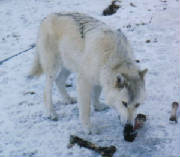
|
| courtesy Mike C. |
2) Can wolves be trained like dogs?
A: Yes
to some degree and no. I have always considered wolves very cat like in how they
move, and even act in some ways, training is one of those ways. Cats are highly independent and do not like to take direction
very easily, the same can be said about wolves. However give a wolf incentive to work and they will do it, some even
happily so, as it gives them something to do, and works their minds to problem solve.
They are capable of learning commands, however one
has to use positive reinforcement such as a clicker and food rewards. Young wolves
in the wild and in human captive raised situations, look to the leaders in their canine and human pack members, for direction
as they mature, however evolution has designed them, to break out of their dependence on others, and express their independence.
I have found that wolves are of the most independent creatures around. You
can train and teach wolves to do *some* things, however I would not consider wolves bomb proof when it comes to commands and
reliability in training no matter how much time is spent.
3) What are the physical differences
between a wolf and a dog?
A) There are quite a few
physical and biological differences and I will address them below:
1) Wolves’ nails on every foot are darkly colored
as in charcoal (dark grey) (dilute black) to dark black and in the case
of Arctic wolves a taupe color. (The *tips/ends*
of Arctic nails lack color.) Due to various definitions and spectrums of the color
taupe, ranging from light taupe which appears tannish/pink to a smokey brownish color, the color of
actics nails by stating taupe can confuse some people. They do lean more towards a lighter smokey tannish/pink color,
BUT arctic nails can also be a darker taupe, they just are not black. Some dogs can have dark nails
especially dark colored dogs, but wolves do not have clear /pink/ , white/pink , or white nails like the domestic
dog. PLEASE NOTE: That just because a white wolf may have arctic colored nails does not mean it's necessarily
pure canis lupus arctos, I have a pure wolf here that is predominantly arctic and 1/4 another subspecies, besides my pure
arctics and she has the arctic colored nail.
| Wolf's black nails |
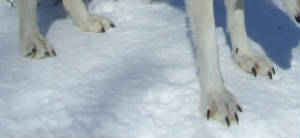
|
| click to enlarge |
| PURE ARCTIC'S NAILS (light taupe) |
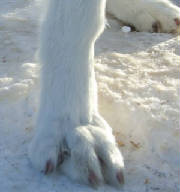
|
| Arctics nails can be a darker taupe however (Click pic to enlarge) |
| Example of darker taupe nails on arctic wolf's paw |
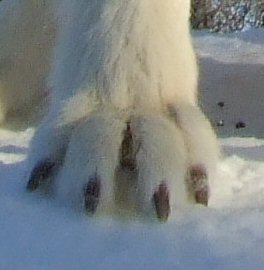
|
| EXAMPLE OF A CLEAR DOG'S NAIL |
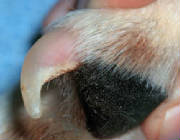
|
| YOU CAN SEE THE PINK QUICK |
| Wolf pups nails are light/white when young |
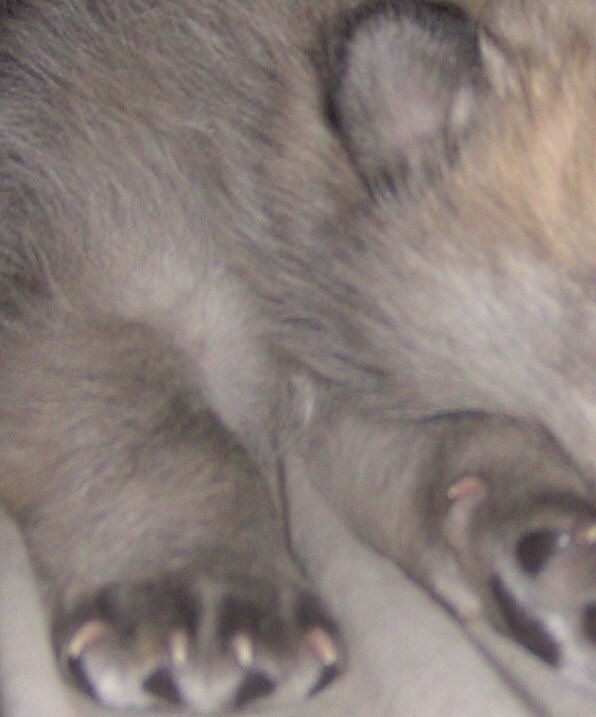
|
| BUT by approx *8-10* wks will have started to transition, and BY 10 weeks at most have darkened up. |
| Black wolf pups nails also start off light/white |
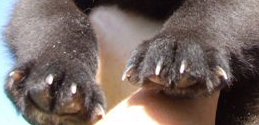
|
2)
Wolves do not have blue eyes this is a domestic dog trait only. Blue eyes is a recessive gene, both parents
must carry this gene for pups to acquire it. Wolves do not
carry this gene. Some pale colors, especially pale greens can sometimes appear bluish in tone and mistaken as blue.
| Purebred Siberian Husky with blue eyes |
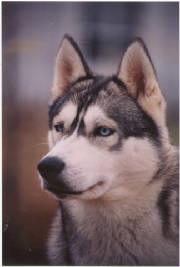
|
| courtesy Jill Porter |
3) Wolves have highly slanted almond shaped eyes with
heavy dark /black eye lining.

4) Wolves have extra large feet, with two very large protruding front toes.
Not smaller and or rounded feet like a dogs.
5) Wolves will not have sharply defined white tail tips like many domestic dogs. Most often one will view wolves that have black tail tips. Some tail tips have
more of a pronounced black tip than other's might have. Please Note however, that domestic dogs
can also have black tail tips *example* included here
| Note the black tip on this wolf's tail |
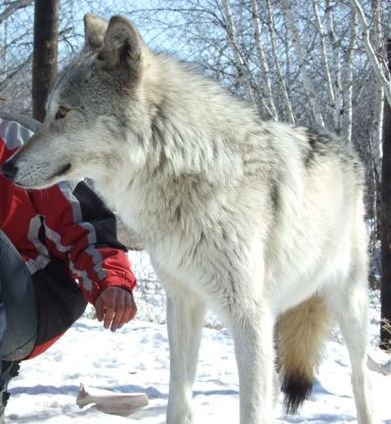
|
| click to enlarge |
| Picture of white tail tip on a purebred dog |
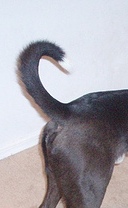
|
| Black tail tip on domestic dog |
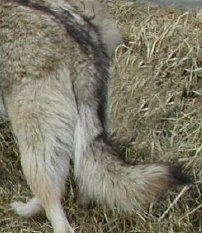
|
| note the slight curl on dog in motion |
6) Wolves have a caudal mark/scent gland *often called precaudal gland* (a dark spot positioned approx. 3-4 inches down from the base of the tail,) it can tend to have a bluish tinge to it with
a few longer stiffer hairs that poke out of it. The spot can be
a few different shapes. Even Black phase wolves though it is harder to see have this spot on their tail. Some black phase
puppies have a few white or black stiff hairs poking out of this area. The spot looks a little shinier in appearance.
MOST Domestic dogs even *if* they have the mark itself on the tail (which still would not be all
that common, are most likely to be seen on dogs with wolf heritage or old working northern breed lines,) however it is
not a functioning/working precaudal gland. PLEASE NOTE HOWEVER : That there is a breed of
dog called the Rhodesian Ridgeback this older breed (often called the African Lion Dog Or African Lion Hound) surprisingly though classified as a sight
hound has a precaudal gland and it is said to be a functioning one at that. Wolves also have scent glands between the toes and on the face. (On cheeks close to the mouth, behind the ears and in the eyes) as well as a few glands
close to the anus (both sides as well as immediately below.) The wolves at AWA on a daily basis like to rub their heads/cheeks,
against objects, be it each other or even trees/fences, and even us their caretakers! This is away to let others know they
were there through scent marking.
| CAUDAL MARK ON ARCTIC WOLF |
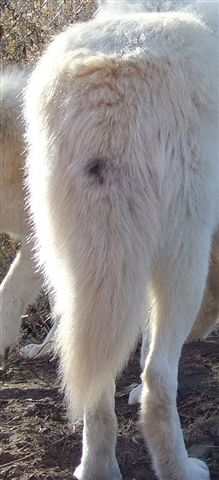
|
| CAUDAL MARK ON BLACK PHASE WOLF PUPS TAIL |
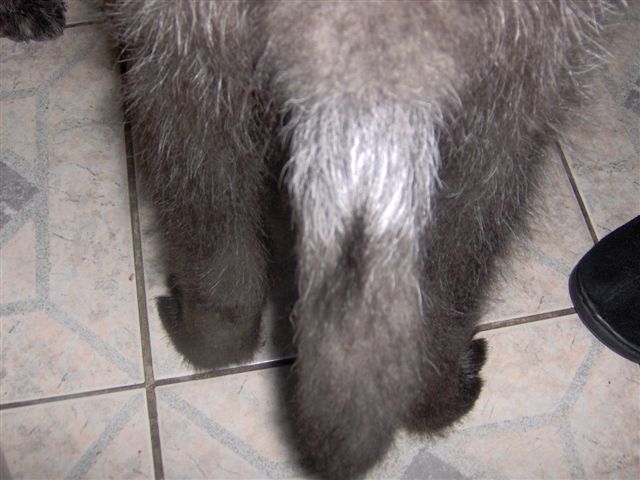
|
7) Wolves’ canine teeth are very large and they are more curved and thicker
than the typical domestic dogs teeth are, they can reach lengths up
to just over a couple inches long. They are adapted to crush huge bones
in one crunch. Claws and Jaws work together to hold down the meat, (claws which also can rip up hide) and jaws to cut/slice,
shred, and break bone.
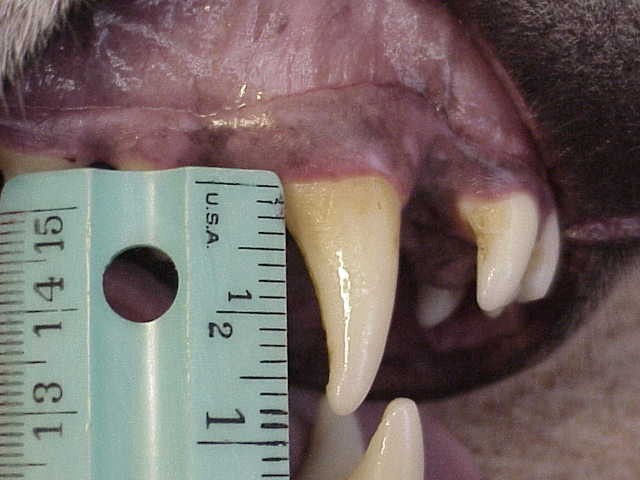
8) Wolves’ chests are so narrow their legs appear to be side by side causing their large feet to splay to the side
when standing still. Legs are long and lanky. Shoulders
& butts are narrow for faster acceleration.
| wolf front in summer appearance |
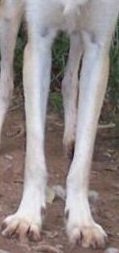
|
9) Wolves back legs have a significant cow hock look to them when at a standstill. The tail is slightly in the way in this picture of Tibet
Night Song, but cow hocked means the canines hocks turn in, which makes it's toes point /splay outwards.
| cow hock |
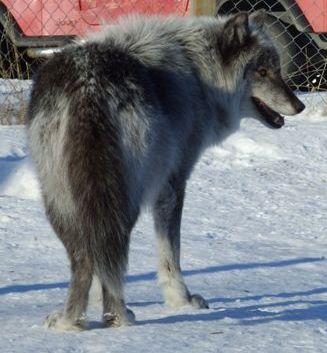
|
| click to enlarge |
10) Wolves have banded fur
and it lies differently than a dog’s fur does. Wolves have a banded pattern
of fur ticked with stiff black hairs approx 1 ˝ inches long that outline a v shape draping down their backs, (dorsal cape) some capes are more readily noticeable than others. On black
wolves it is still there but harder to see. (Banded means each individual hair has a few different colors per strand.) See
pic. The dorsal cape starts behind the shoulders and comes to a point on the mid back.
| BANDED FUR |
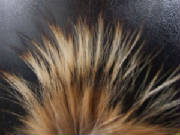
|
| wolf dorsal cape on white wolf (click to enlarge) |
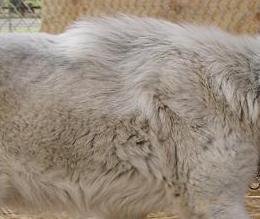
|
| though not ticked with black you can clearly see the longer guard hairs making up this dorsal cape |
| Dorsal cape on grey colored wolf, click to enlarge |
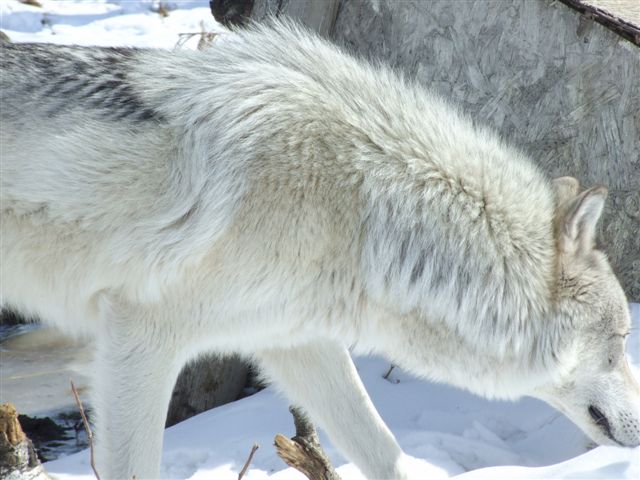
|
| look just behind the shoulder blades on the upper back down |
11) Wolves though they have (dew claws) a fifth digit on the front paws, they will not have rear dew claws like many dogs can and do have
12) Wolves’ tails when they walk will not curl up or
over their backs like a dogs tail will. Wolves’ tails are extremely straight.
Even dog breeds that have straighter tails (Like Geman Shepheds for example) will still have a slight curl to them
when they run or walk/prance. A Wolf's tail will however depending
on their mood, show a lot of different emotions, and can be held in various positions from straight out in a horizontal position,
to straight up in a vertical one, and everything inbetween.
| wolf at a trot |
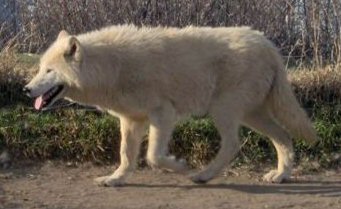
|
| German Shepherds Tail Curling Up |
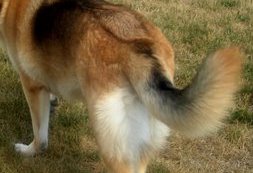
|
12) A
wolf’s
fur (pelage)changes color consistently as it ages. Some more drastically than others. A black phase wolf can be born pitch black, yet
phase so light they can appear almost solid white or bright silver by the time it is 6 years of age. Black dogs even though they may get a few white hairs as they get to
be seniors, stay black. Even grey/silver colored wolves change color, although may not appear as drastically to phase
as black wolves do over time.
| blackphase pure wolf pup |
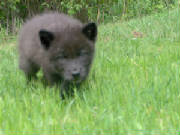
|

13) Wolves can have many vocalizations, but do not bark like the typical domestic dog does. They have an alarm bark that sounds like a rapid
blowing, fast puffing like sound, or a high-pitched yip that can almost be coyote like and are alarm calls. Wolves can also scream when agitated/alarmed. Wolves are by nature very quiet shy animals, and unless you
live with them you would be hard pressed to ever hear them
alarm bark/scream, since wolves are not easy to view in the wild to hear such sounds.
14) Wolves howl, and though domestic dogs
can howl some being pretty darn good at it even, I have yet to hear this
howl mimicked by a domestic dog in quite the same way and range/pitch as a wolf’s howl. A wolf’s howl
is one of the most haunting beautiful sounds to ever hear. And for the most part unrivaled by domestic dogs.
15) Male
wolves testicles will be peanut sized all year round (and not fertile) until mating season once a year in the winter months
to correspond with a female wolf’s estrus, after mating they will once more shrink down so as to barely be noticeable,
unlike a male domestic dog whose testicles remain the same size all year, and is able to mate any time of the year.
16) Wolves will not have pink/black, pink reddish noses.
| Siberian Husky and Malamute cross |
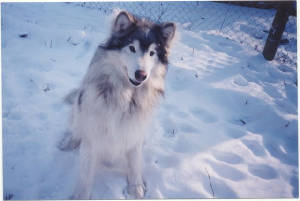
|
| This dog has a pink and black nose seen often in northern breed dogs. NOTE: the open white face |
17) Wolves eyes can be various shades of amber from light to dark
( yellow orange- brown orange) various shades of yellow from pale lemon colored to a deep gold, various shades of
green, and yellowish green, in the case of arctics they have a brown looking eye when young which lightens up some over
time but will still not be light yellow,(in certain light and when photographed actics eyes can appear a lot lighter than
they actually are) What wolves won't have is blue eyes. (wolves do not carry the blue eyed gene which is
a recessive trait in domestic dogs) Wolves eyes are
characteristically marked with a heavy dark black eye lining. Wolf
pups eye's start off with various spectrums of blue from light to dark, they will go though a few different color changes
till their final color by a few months of age, although they will tend to lighten up a bit over the first year. Wolf
pups eyes transition from either blue to blue green/ blue to grey colored or grey green, or green to finally their
determined genetic shade one of the above colors.
18) A wolf’s nails/claws
are thicker and larger than the typical domestic dogs used for helping to rip open prey’s tough hides during hunting
and for then eating.

19) Wolf pups are not
born with distinct markings & masks like Siberian huskys, German Shepherds or Alaskan malamutes. Please look at the domestic DOG pictures provided,
CAREFULLY. PURE wolf pups including arctic wolves are born darker colors,with well-blended
fur. Not sharply defined white markings on their feet, on their noses, on their foreheads, or
have *large* white chest markings. Arctic wolves are NOT EVER
born WHITE please look at the photo of the young pups said to be arctic wolfcross pups, being born WHITE is a DOG trait NOT
a WOLF trait. Many white DOGS and crosses are sold as arctic crosses when they simply are NOT. Please go to legend
and ecos page on this site to see how true arctic wolf pups look like when young.
| wolfpups uniform in color |
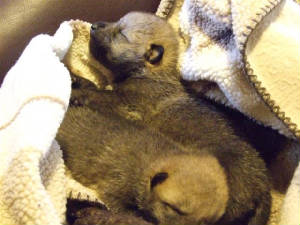
|
| NO sharply defined white markings such as white booties, white stars on foreheads,open white faces |
| Purebred GSD puppy |
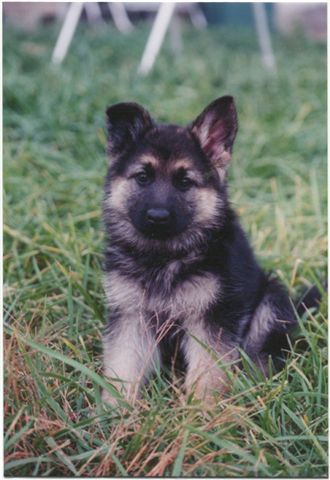
|
| courtesy Jill Porter |
| Purebred Alaskan Malamute Puppy |
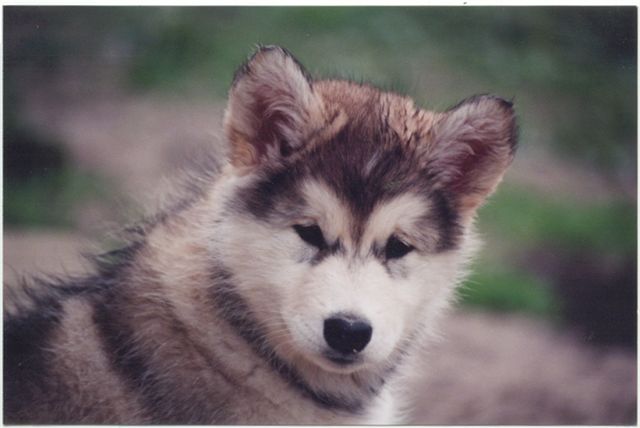
|
| courtesy Jill Porter |
| PUREBRED registered Samoyed |

|
| Samoyeds are born white |
| Young Purebred Siberian Huskys |
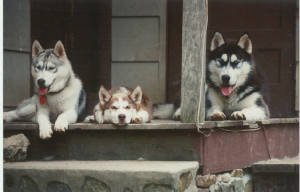
|
| Few different color ranges. PLEASE look at the open white faces ,and masks these purebred DOGS have |
| Purebred white siberian husky (BORN white) |
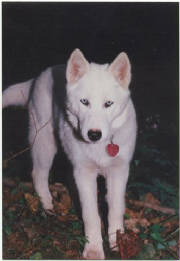
|
| courtesy Jill Porter |
| Alaskan Malamute and Siberian Husky with blue eyes |

|
| NO ARCTIC wolf in this DOG puppy! being born white is a DOG Trait! |
20) Wolves skulls differ from domestic dogs the width, height
and length is larger, the orbital angle is different, (45 degrees for wolves compared to a dogs 53 degrees) The sagittal crest
(raised area of bone at the back of the wolf's skull is more pronounced.) This bump can clearly be felt on the wolfs head
when felt, some jokingly call this a brain bump. Please go here for a more indepth tour into a wolf's skull
| Comparison dog skull (left) with 3 wolf skulls |
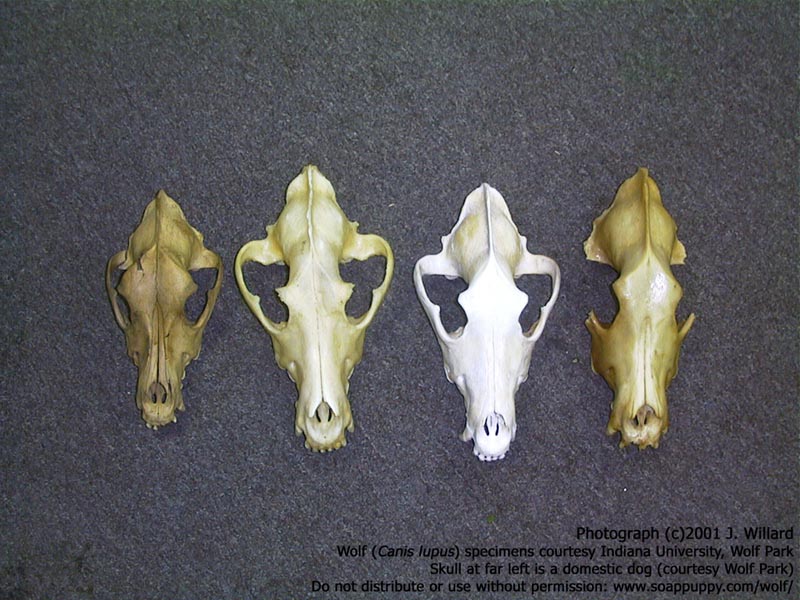
|
| credit www.soappuppy.com/wolf |
| Wolf Skull Left Side View |
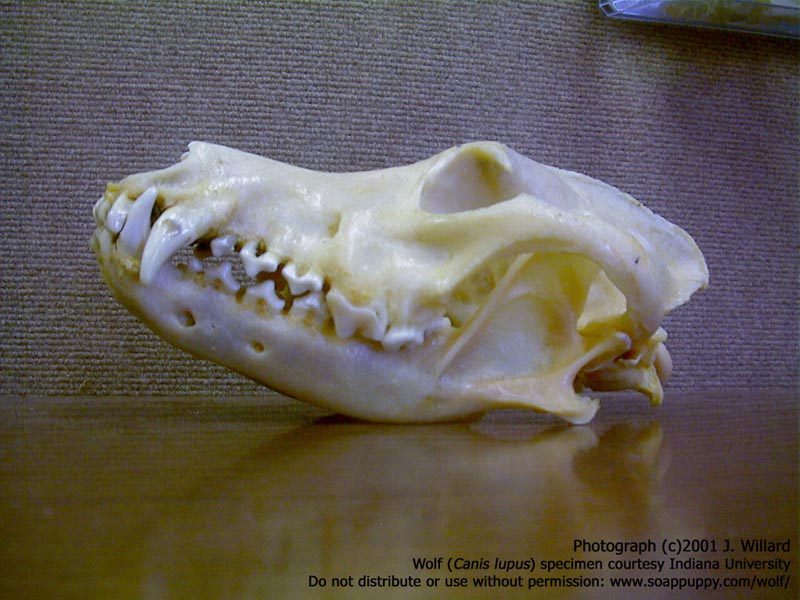
|
| courtesy www.soappuppy.com/wolf |
| Front view wolf skull |
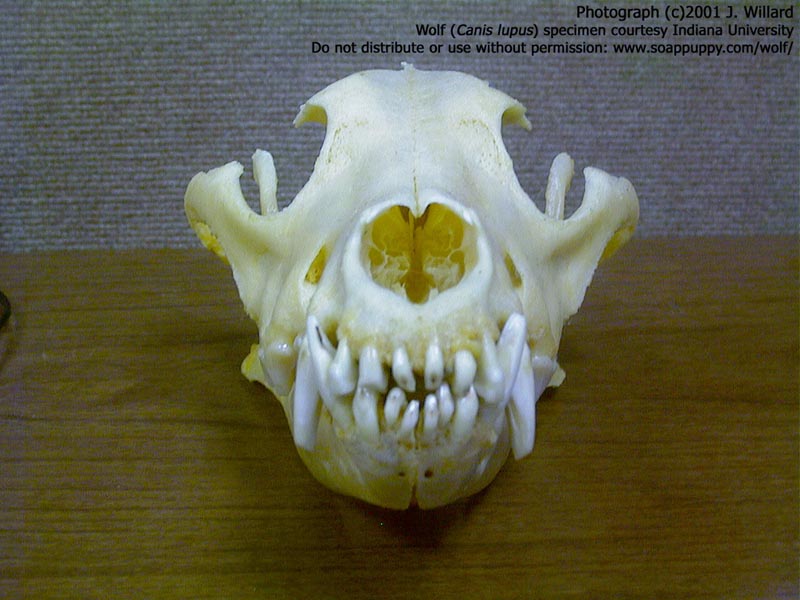
|
| courtesy & thanks to Jess at www.soappuppy.com/wolf for the reprint permission of pics |
21) Wolves do not not *generally*
become sexually mature till approx their second winter (22 months of age to their third winter even) Where
as dogs sexually mature approx 6-8 months of age, and can produce offspring. BUT please keep in mind I used the
word general and being sexually mature does not mean because they have a first heat their first winter, they are mature.
I have personally seen verified pure wolves come into their first heat at 10 months of age (not any younger than that,) and
I should note that at wolf park www.wolfpark.org a study was done to check the viability of sperm in male wolves their first winter, and it was found to be *possible*
for them to mate their first winter. It is an old wives tale *myth* that wolves do NOT come into their first heat until
their second winter, there many cases of female wolves coming into heat (estrus) /(bleeding) their first winter,
although it is *possible*, it is still rare to observe female wolves acually mating their first winter,
even if they go through estrus. But anyone stating wolves absolutely *cannot* mate their first winter, male or female
this has proven itself to not be true.
*In Dr. L.D Mech's book {Wolves: Behavior, Ecology, and Conservation} he states a case of a captive female
wolf it's first year, having given birth even.
22) Wolves single track; (as do coyotes and foxes) in the great outdoors
one can tell the difference between a wild wolfs tracks, and a large domestic dogs tracks
by their appearance. Single tracking is where the wolfs back paws, are placed in the front paws tracks when
moving as to form a straight line, dogs tracks are more *staggered*. (*Unsteady and uneven gait thus domestic dog tracks
will not be in a line.*) A dogs chest is proportionally wider than a wolf's is, thus a dogs rear hind foot
will be placed *beside* the front track.
| BACK PRINT PLACED IN FRONT |
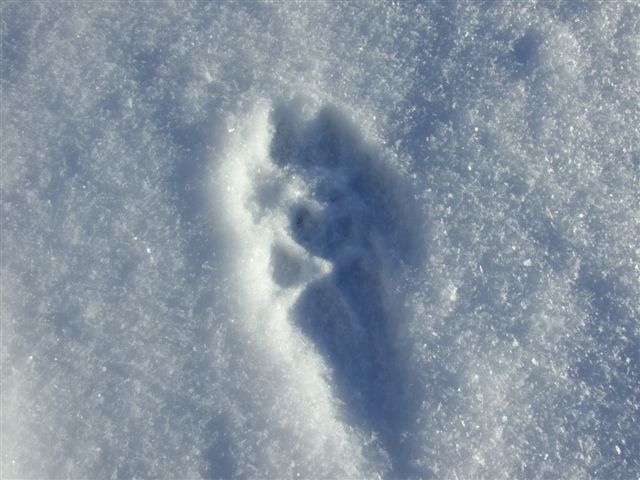
|
| WOLF TRACK |
| SINGLE TRACKING |
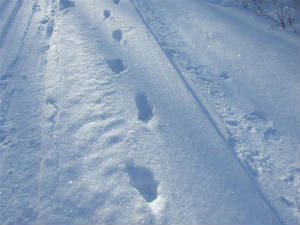
|
| WOLF TRACKS |
23) Wolves are a territorial
predator, and will attack other animals that encroach on their territory, including other wolves, wild
canids, and dogs. If the coyote population is dense
in an area, you know wolves are not really around, as wolves would not share their territory, and would kill off any coyotes
they came upon.
24) Wolves have *webbed feet* skin that is attached
between the toes, this aids them not only like snowshoes in the winter but also to help them in swimming, and for better traction
and grip on slippery surfaces.
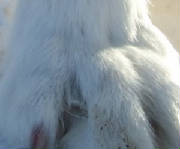
25) Wolves have thick double coats,
the dense undercoat acts as insulation to keep a wolf warm and cozy during frigid cold weather, and the coarse outer
coat /guard hairs act like an umbrella, when snow lands on a wolf's fur it will sit atop the fur and not penetrate through
the thick undecoat, it also helps to keep the wolf warm when it rains. A wolf's guard hairs act as insulators
due to the hair shafts being hollow.
| Snow resting a top the fur |
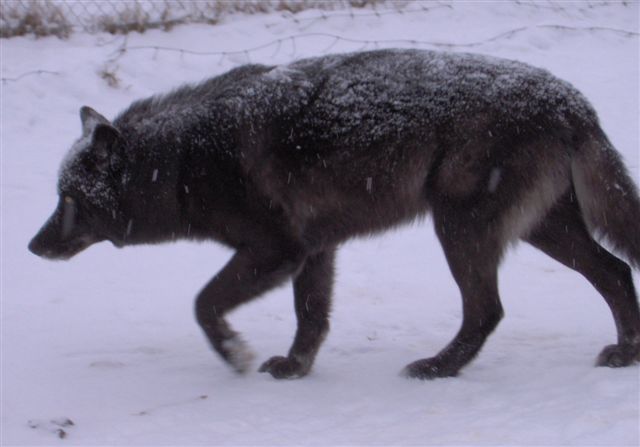
|
26) Wolves
have smaller, rounder, thicker, well furred ears, NOT larger, thinner, or pointier ears like German
Shepherds.
| Wolf ears (click on pic to enlarge) |
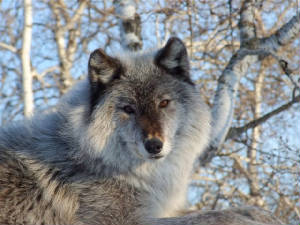
|
| NOTE the rounded tips, THICK smaller ears, and all the fur within the ears |
| White German Shepherd Ears |
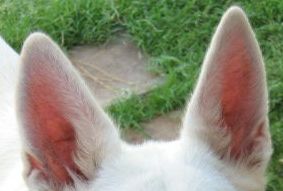
|
| Please note the large size with not much fur within the ears |
| German Shepherd cross (Not an arctic wolf cross!) |

|
| This dogs ears are fairly well furred , rounded tips, BUT are TOO large |
| Purebred Sibe ears |
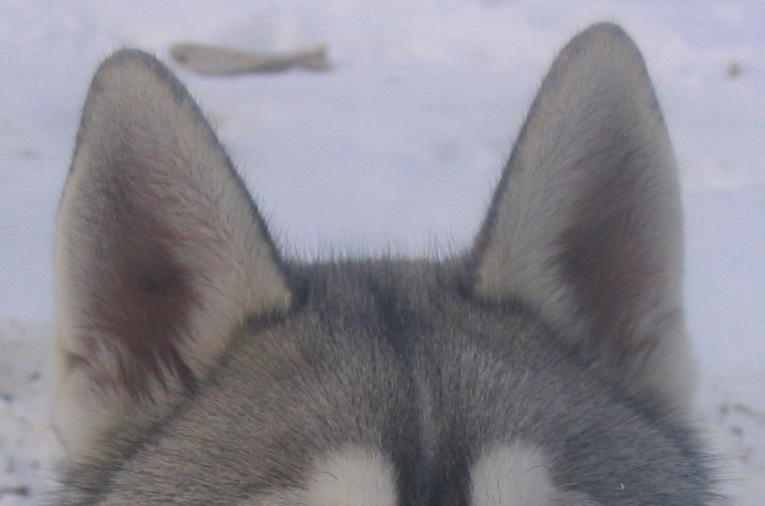
|
| Ears are more thinly furred and thinner than a wolf's ears, have more triangular tips/shape |
| German shepherd, malamute and wolf cross ears |
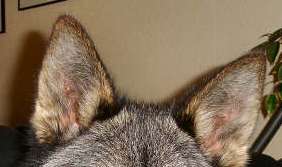
|
| Ears are too big!fairly well furred ears, BUT not furred enough,Can still see some pink within |
| Purebred German Shepherd ears |

|
| Malamute, Shepherd, wolf cross ears |
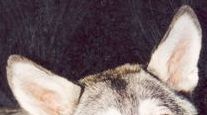
|
| Ears are too large to be a wolf's, some pink can be seen within, fairly well furred but not enough |
| Wolfcross ears |
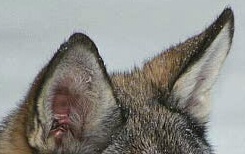
|
| Ears are to thin, and not furred enough, can see some pink within, shape is too triangular |
27) Wolf
pups will NOT have pink or pink and black paw pads. Every single one of the paw pads on wolf pups will
only ever be black. They are born with solid black pads. (pic of just under
two week old wolf pup and pic of 2 weeks old canine pup with some wolf heritage) Even if the paw pads fade to all black
within weeks, the fact the pup has this trait to begin with at birth and any time period onward SHOWS dog heritage. NOTE: The pics in my presentation shown of pink/black paw pads, did turn to solid black, and did not stay pink
and black.
| black paw pads |
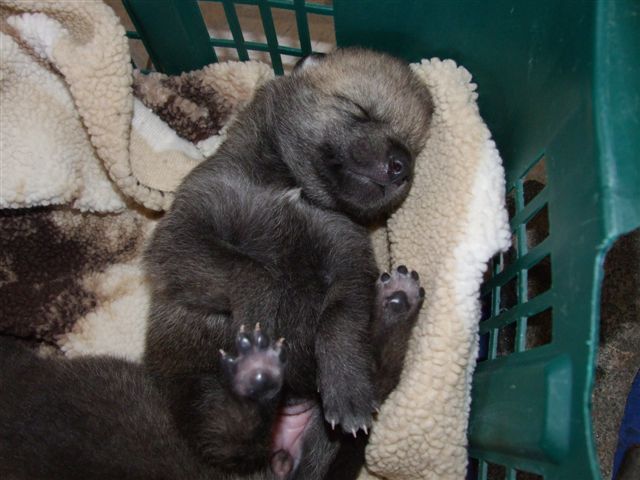
|
| Pure Wolf Pups will NOT have Pink & Black Paw Pads |
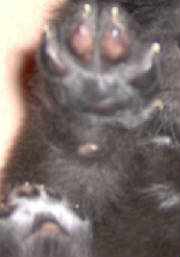
|
| young canine pup with pink and black pads |
28) Wolf
pups ears are erect/standing by 3 -3 1/2 weeks of age not flopped over till 4 or more.
| 21 day (3wk) old wolf pup |
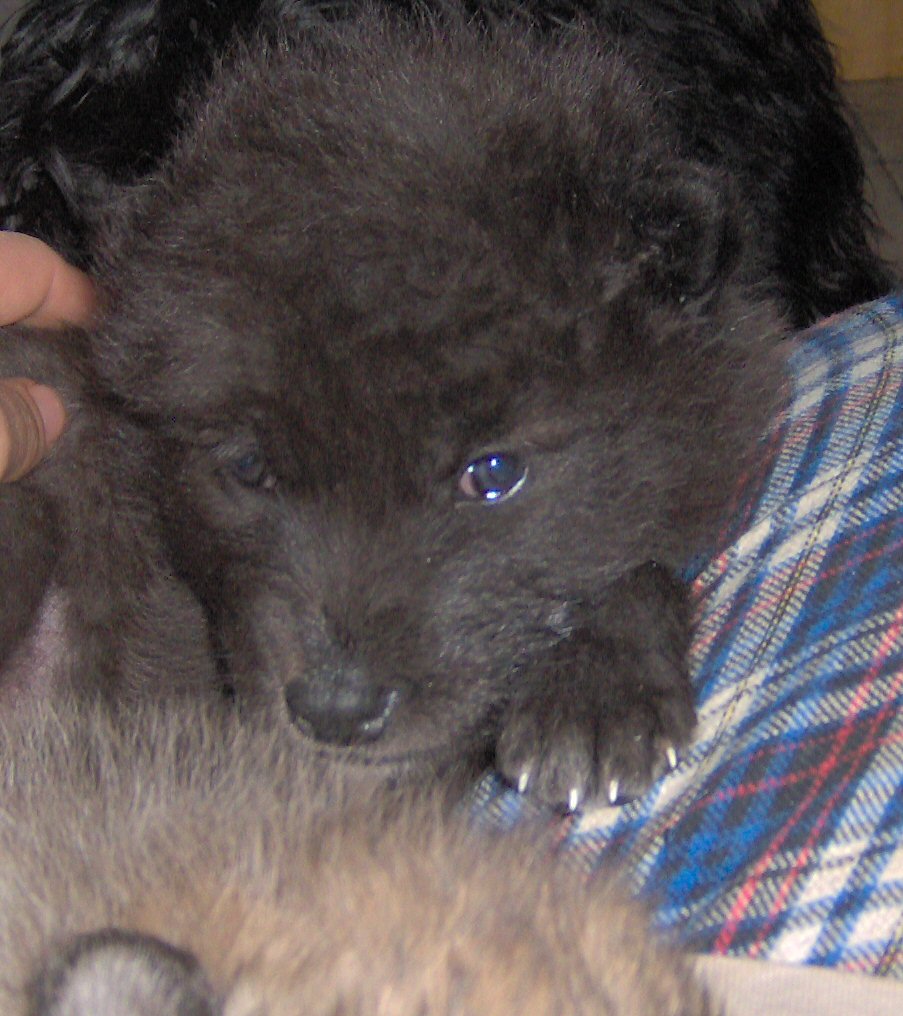
|
| note the little round ears perked up, click on pic to enlarge |
29) a) Wolf pups will NOT be born
with larger white stars/markings on their heads and or noses, even if this fades out once the pup is quite
a bit older, it does not matter.
b) Wolf pups will NOT
have sharply defined white socks/booties.
c) Wolf pups will NOT
have flopped over ears till 4 weeks of age or more. PURE wolf pups ears WILL be standing BY 3 -3 1/2 weeks of age.
d) Wolf pups will not have large white chest markings
e) Wolf pups will NOT be born with pink, or pink and black
noses (even if the nose turns black fairly quickly.) A pink and black nose shows dog genes.
There are some places who state they have wolves in
captivity but have wolf crosses/wolfdogs/dogs with wolf heritage, not pure wolves, and such places
have NOT had DNA tests done to PROVE otherwise.
Wolves follow certain rules biologically and physically,
captivity does not change these rules. The following are pics that are of DOG
traits NOT PURE wolf traits, if you see photos with pups that are stated to be pure wolf, and they have these traits when
young, they simply are NOT pure wolf but have dog genes. Not any lab can do proper DNA testing either, the USFWC forensics
lab in Oregon is the leading lab *at the moment* set up for such testing. Please read further down for more info. on this
subject. PLEASE NOTE: That any of the following traits can be independant
of the other, or all combined. Each individual physical trait in the examples, shows dog genes.
| PICTURE OF DOG STAR AND FLOP EARS ON A 3 WEEK OLD |

|
| EARS ON PURE WOLF PUPS STAND UP ERECT AT AND BY 3 WEEKS OF AGE |
| WHITE SOCKS/BOOTIES ARE A DOG TRAIT |

|
| Traits NOT seen in pure wolf pups |

|
| NOTE THE *LARGE* WHITE CHEST MARKING SHARPLY DEFINED (THIS IS A DOG TRAIT) & PINK AND BLACK PADS |
| CANINE PUP BORN WITH PINK & BLACK NOSE |
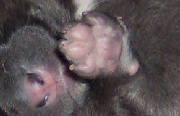
|
| PAW PADS PINK AND BLACK (NOTE: PUPS NOSE AND PAWS PADS DID TURN SOLID BLACK BY 4 WKS) |

|
| PUPPY WITH LARGE SHARPLY DEFINED WHITE MARKINGS STARTING UNDER THE CHIN DOWN |
| NOSE/HEAD STARS |
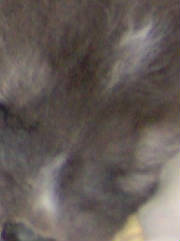
|
| EVEN THOUGH BOTH MARKINGS FADED/BLENDED COMPLETELY AWAY THIS SHOWS VERY EARLY ON THE DOG GENES |
30) Wolves,
unlike dogs, lack sweat glands in their paw pads.
31) Wolf pups are ALWAYS born
in the early to late spring months once a
year.
(Whelping months/dates being Mid March leaning more towards the third week of March to the end of May.
Not June through Feb. In the wild, the month of birth depends on latitude, thus also the sub-species
of gray wolf. So a subspecies of wolf like an Alaskan Tundra, would have a later whelping date than a subspecies of wolf that
exists in a more southern area naturally, while still falling into the parameters of the whelping months/ dates listed. Wolf
pups are not
born in the summertime and fall/winter months! Captivity does not change wolves biologically.
Meaning, a pure arctic wolf in captivity in Texas for example, will follow the
same whelping date it would if it were living in the high arctic.
For reference please *click on link below which takes you to to Dr. Mech's
site and book listings, you will find verification of the above facts at the following book referral by A Wolf Adventure*
32) Wolves shed ONCE a year which starts in the
later spring/early summer (June and July) not twice a year like most dogs. Their under coat and guard hairs
come out in clumps. A Wolf's undercoat and guard hairs will shed out (Nature's haircut) and never matts up like dog's
fur does. By Fall the coat has completely regrown again. Unlike a dog that systematically sheds a great
number of hairs on a daily basis, (do you have a dog and peple KNOW you have one, due to wearing their fur to work ;0))
a wolf's fur does not shed on a daily basis to the degree dogs fur does. (I dont wear fur to work on my clothing!) There is
a reason you will not see calendars of wolves in summer coats, for they get quite ratty/mangy looking when their glorious
winter garbs initially disappear. By Mid summer however, they do return to being at least respectable looking in their shorter
sleek coats. :0)
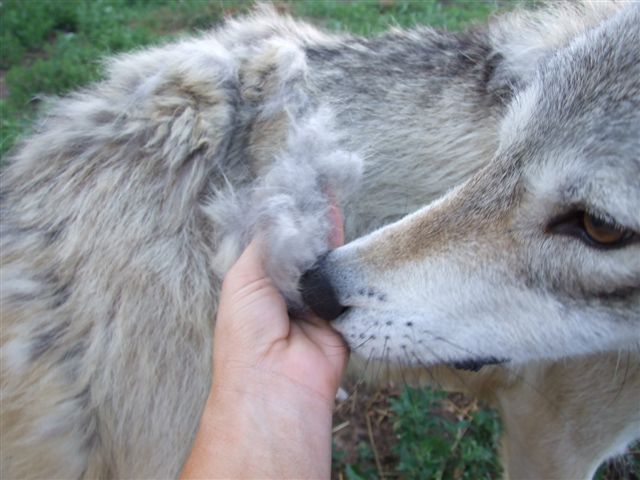
4) How fast Do wolves run?
A).A wolf
running at top speed can reach speeds in short bursts of 35mph, thanks to their long and powerful legs that were built for speed
and endurance in
chasing prey.
5) How big are wolves feet?
A)
Wolves’ forefront (front paw) prints can be approx 4-5.5 inches in length and approx. 3.5 to 4 inches wide and are always bigger than the back feet. Their feet are well padded to help spread their weight over snow like canine snowshoes, it also helps them to
grip surfaces such as rocks and logs well.

6) How good can wolves hear?
A) Wolves ears are well furred inside and out, and are fairly short/broad with rounded
tips. Their hearing is extremely sharp and can hear sounds as far away as 6 –10 miles depending on terrain.
Wolves can hear sounds undetectable to humans ears, (high pitches) and sounds such as rodents knawing underneath the snow, as their furry ears are sensitive to lower frequencies.
If you ever watch a dog when a sound occurs you will notice they will cock (tilt) their heads, or their ears may turn in directions
independant of one another, this is kind of like antennaes trying to receive a better sound and tune in.
7) How well can wolves see, and
can they see in the Dark?
A)
A wolfs eye sight is quite keen; they detect even the slightest of movements so they
can find and follow prey. They have excellent peripheral vision even though their eyes are situated on the front of their
skulls. However, detecting details on the object of focus is not as good, wolves though they notice movement immediately,
no matter how slight, they have a harder time viewing details of the objects they may spot. The farther away the
object is the worse their vision gets, this would be called being near sighted in humans,or myopic. I have often
remarked during observation of my own wolves, how they almost seem to be blind in some instances, as they have mistaken
me, and even spooked thinking I was some stranger if they see me from a great distance approaching, till I speak to let
them know it is me. Wolves although they have binocular vision like humans (the fovea responsible for sharper focus is not as well developed as it is in humans) but despite this wolves see amazingly well
at night due due to having more night vision cells (rods) than we do, these rods react to lower light than cones. Wolves have a larger pupil than in humans which allows them to gather more light when it is scarce. A
Wolf's eyes also glow within the tapetum , though this helps a wolf's vision in dim light, it will also scatter some of that light which will degrade the canine's
vision significantly. Wolves rely on their eyes, but their other senses their hearing and sense of smell are
well honed, and very sharp to make up for what the eyes may lack.
8) How well do wolves smell?
A) The wolf’s
sense of smell is said to be 100 times greater than a human beings. They can smell their prey from
as far away as a mile and a half. A wolf's sense of smell is vital to it's very existence within a wolf pack structure, for being able to not only detect
smell sometimes from great distances, and to communicate with each other, but also interpret that smell which allows a wolf
insight into the animal that may have left the scent, (prey/enemy) even if the animal may be ill/dying. Whenever I have visitors
at the ranch, after the people leave the wolves will immediately go to every spot the visiting person (people) may have been
sitting/ standing to sniff, and gain infomation.
9) How many teeth do wolves have?
A) The wolf has
42 teeth, consisting of two canines, six incisors , eight premolars, and four molars,
in the upper jaw. Two canines, six incisors,
eight premolars and six molars in
the lower jaw.
10) How strong are wolves teeth?
A) Wolves have extremely powerful jaw strength. They can generate
pressure of 1500 pounds per square inch (psi), twice that of a a German
shepherd. Their teeth were made to eat meat, growing to seen lengths of up to a
couple inches. Their teeth are very thick
and large for tearing and and ripping into thick hide and skin of their prey.
11) How
far do wolves travel?
A) Wolves in search of food have been known to
travel 25 miles in a day or more.
12) What is
a wolf pack ?
A) A wolf packs consist of family members,
mainly offspring of the main dominant breeding pair. The omega wolf in the pack is the lowest ranking animal, and the
one the other wolves may take out their social aggressions, and stress on *beating the omega up*, the beta is the second in rank, with the alpha being considered the most dominant
and the leader(s) The omega actually plays a vital role in keeping stress, and animosity levels down within the pack. You
will often notice the omega within a pack as the one who most often shrinks down in size around some of the other wolves.
They accomplish making themselves smaller, and less threatening, by lowering their heads, tucking their tails, averting their
eyes, curving their backs, and lowering themselves even closer to the ground when approaching, or being approached by a higher
ranking wolf within the pack structure.
13)
How much do wolves eat?
A) Contrary
to popular belief wolves are not the most successful of
hunters, and must work as a family unit together to bring down large game animals. Their success rate is approx 1 in ten animals that are pursued, this means traveling sometimes great distance and testing many prey
animals before a success. Wolves work very hard *together* for what they do manage to kill. Wolves
survive in the wild under a feast or famine scenario, when they are successful with a hunt they gorge themselves and
eat as much as their bellies can hold, (feast) for they may not eat for a number of days there after, (famine) until a next
kill. Wolves can eat up to 20 pounds of meat or more in one
sitting.
14) How many pups do wolves have?
A) Wolves give birth to smaller litters on average. Wolves give birth to approx 1-7 pups with 3-5 being most common.
Pups are born after approx 63 days of gestation , and are born blind
, helpless, and well furred.
15) How big are wolf packs?
A) Wolf packs can consist of as little as 2 members all the way up to 25 plus members, it depends on the area they may
reside, (more isolated areas with less threat to their livlihood (food source, habitat and their physical lives, packs tend to be larger) packs in general however consist of approx 5-10 members.
16) Do wolves make good pets?
A) Absolutely not! Neither being raised in captivity, raised in a house, being trained, or raised with a *dog* changes
what a wolf is...a wild animal in a domestic situation. Some lines of wolves may have a higher tractability *easier to work
with due to selective breeding over many years* but even they are
STILL wolves, and come intact with all things that make a wolf a wolf. Captive wildlife do not lose their inherent nature,
or natural intensity, simply because someone raises it like a pet. If anyone/facility does share their life with
wolves there are a few things to be aware of in meeting ALL the *needs* of such high maintenance canids they are as follows:
1) Companionship: Wolves are
very social and complex animals, they require companionship in the form of another canine to meet their emotional needs. I
recommend placing them with another canine of the opposite sex around
it’s own size. This way they will not be lonely.
2) Not allowing wildlife
to run free: Never
allow a captive wolf to run free, like some farm dog. This is a sure,
and fast recipe for disaster and even a possible lawsuit. The wolf can be shot, come up against some wild canid (such as another
wolf or coyote), porcupines, chase, harass even kill other neighbors livestock
(chickens, small animals etc.) The wolf should be in an escape proof roomy enclosure to keep it and the public
at large safe.
3)
Socialization: Make
sure the wolf (wolves) are socialized heavily to a variety of people, places, objects, experiences. Wolf pups need to be hand raised (bottle-fed) from the age of
2 weeks and socialized to both sexes (male and female humans,) to ensure they will be adequately socialized to humans for life.
Even if the mother is social pups not pulled will be difficult to handle as adults (will be flighty). This poses problems
when the wolves require even routine medical care, let alone emergency
vet treatment. Please do not make wolves suffer for any short cuts taken in this process. Keeping wild animals unsocialized
in a captive environment can create great distress.
4)
Insurance: some licensing requires liability insurance, in case of any incidents involving
the wolves in your care. (Such as an escape or bite)
5) Healthcare: Seek out a vet that will not be scared of wild animals,
good vets are hard enough to find. Don't attain the animals FIRST and then try to acquire a veterinarian.
6) Enrichment: Provide environmental stimulation and enrichment
in its every day life. Platforms, trees, old logs to hide treats, water troughs/swimming pools to lay in dig in, sand boxes
to dig in, etc. Keep their minds stimulated. (see enrichment page)
7) Containment: If
there is one step that is VITAL to keeping a wolf (if licensed) it is escape proof containment. 8 foot tall 9-
gage chain link with two foot tall lean-ins at a 45 degree angle inwards is highly recommended. Some people opt to use hot
wire on top of that. Some places go straight up using ten-foot tall chain link. Given incentive I have seen wolves
scale the tallest of containment. The goal is to prevent escape the first time as once it is attained the wolf never
stops trying to get out then. Dig proofing should also be implemented
one can weave 4-6 foot tall chain link onto the main fencing for dig proofing, some people trench around the enclosure first
then lay down the chain link weave it on then backfill with dirt and then gravel. 11-gage for main containment should
not be used, it is incredibly easy for wolves to chew through or to bend/destroy.
8) Nutrition: Understand the nutritional requirement of wolves. Some of the food many dog
owners get away with feeding their domestic dogs, will and can make wolves very ill.
9) Legalities: Make sure you have checked all the local laws
regarding owning wolves in your area and if you require any licensing or permits, if you need such attain those FIRST before
getting a wolf illegally. In the case of pure wolves they should not
be kept in the city in someone’s back yard as a pet period.
10) Volunteer: The most vital of all before launching
into such a financial and emotional commitment is to get experience, and learn about wolves FIRST, so you get to see
ALL what makes them what they are, and I dont mean reading about them from just books, or how great of pets they make
from ignorant people on the internet. Contact us here at A Wolf Adventure to learn about wolves, or get in touch
with a facility like wolfpark www.wolfpark.org they have programs where people can volunteer, or take classes through them to learn
more indepth about wolves. It very well could turn your thinking right around.
17) When
are wolf pups born?
A) Depending on latitude *Higher the latitude like Arctic wolves, and Alaskan wolves, the later it occurs (Mech)*
Gray Wolves breed anywhere from Late Jan, (with February being typical) into March, with pups being born in the spring, late
March (April being typical) throughout May in the case of
Canis lupus arctos. Wolves (including the arctic wolf) are not born in the month of June onwards. Alaskan Tundra's, Alaskan Interiors,
and Arctic wolves have typical may birthing dates in the wild, from early May to the end of May. Although
depending once more on the latitude some northern wolves such as canis lupus hudsonicus can have later April birth dates.
Gestation is the same as dogs approx 60-63 days.
18) Why are wolf pups born in the spring?
A) Wolf pups are born in the spring months so that they have
enough time to grow big enough (6/7 months of age) before the winter hits. In the spring there is also lots of food sources
for the adults to feed on, (deer, moose etc also giving birth to young as well) and thus supply plenty of food for fast gowing
puppies. Pups need to be strong enough and big enough by wintertime to keep up with the
adult wolves in the pack as they hunt . (It's a rough life in the wild!) Pups
born in the summer would not be grown *enough* by the fall/winter months, and if pups are born in the fall or winter not only
would food resources start to become more slim, but young pups could not be kept warm enough, and would perish from the cold.
19) What do wolves eat?
A) Wolves eat a variety of food sources depending
on the geographic range/region from where they reside. Because wolves are predators however they also are meat
eaters, so main prey consist of deer, moose, caribou, elk,
fish, some game birds, squirrels, beavers, and rabbits. Wolves cannot digest plant matter that well (due to a
smaller digestive tract) unless pre-digested first within the prey's *for example a deer's* multi chambered (4) stomachs first.
20) Do wolves like to swim?
A) I
cannot say whether they *like* to swim, but can say they do like the water, and will play in it, and swim in it, the water
not only quenches their thirst, but can help to cool them down in hot weather. Wolves have webbed feet (skin between their heavily furred toes,) this aids in them being excellent paddlers.
In the winter time their webbed feet make excellent snow shoes!
21)
How much do wolves weigh?
A)
Wolves appear much heavier and larger than they actually are, due to their thick
heavy coats. Weights can range as light as 55 pounds for a small female, on up to 130 pounds or more for
a male. Height ranges are approx 26 inches at the shoulder (withers) on
up to 35 inches at the withers. The heaviest recorded wild wolf was weighed in at 175 pounds. (Mech) Arctic wolves (canis
lupus arctos) tend to generally be heavier than other sub species of wolf.
22)
How much do wolf puppies weigh?
A)
Wolf pups weigh approx. a pound when born.
23)
How long do wolves live?
A) A
wild life is a very hard life, because of this, wolves do not live as long as their captive born counterparts. In the wild
a wolf is lucky to reach 6-8 years of age. In captivity
however, if well cared for wolves can live to be into their late teens.
24)
What types (species) of wolves are there?
A) There are three types of wolves in the world, with two of the three residing
(Gray wolves,) & ( Red wolves,) residing in North America, and then (Ethiopian wolves.)
SUBSPECIES: There are several, (32) sub-species of Gray wolves, (24)
of these occuring in North America they are as follows:
(Note: Sub-species of any wild animal
are determined according to geographic location/region, weight, size, color, and and cranial (skull size/measurements)
Due to there being no borders/blocks in some geographic areas, it is believed that some subspecies have crossed with others,
making me wonder how pure strain some subspecies are.
North American Subspecies:
Originally there
were 32 subspecies worldwide 24 occurring in North America. In 1995 Dr. Ron Nowak suggested lumping the remaining subspecies
into five subspecies groups which can be seen labeled 1-5 the rest are of the remaining old subspecies listings.
1) Canis lupus baileyi: (known as the Mexican wolf. This dark and grizzled
colored wolf is the smallest member of the North American Grey Wolf. It lives in the Sierra Madre and surrounding regions
of Western Mexico. It once roamed in areas of Arizona and New Mexico. Currently endangered
2) Canis lupus lycaon:
(Known as the Eastern Timber wolf. This
wolf had the most extensive region of habitation than any other subspecies. Its original range covered the eastern United
States. This wolf comes in every color.) Now their range is in the southeastern parts of Canada. Endangered.
3)Canis
lupus nubilus: (Once known as the Great
Plains wolf or Buffalo wolf. This medium sized wolf once roamed across Saskatchewan, Manitoba, all the way down to
Texas) is said to be extinct however studies show that wolves in Upper Michigan, Minnesota, and Wisconsin are Canis lupus
nubilus.
4)Canis
lupus arctos: (Arctic wolf or Melville
Island wolf. This wolf only occurs on the arctic islands from Melville Island to Ellesmere Island. These wolves are large with white-creamy colored coats; they have huge snowshoe feet.
5)
Canis lupus occidentalis: (Mackenzie
Valley Wolf.) Range is Alaska and Western Canada. These are some of the largest of the wolves in North America and
have a varied color range. This subspecies includes columbianus, griseoalbus,
mackenzii, occidentalis, pambasileus and tundrarum.
Old
Subspecies Listing
Canis
lupus bernardi: (Banks Island Tundra
Wolf) this wolf is mostly white with black tips along it’s mid back. Found in the North West Territories.
Canis
lupus columbianus: (British Columbian Wolf) this wolf is among the largest of the wolves, weighing in as much as 140 pounds.
Color wise they are either grey or black and the blacks are usually the larger of the two.
Canis lupus hudsonicus: (Hudson Bay Wolf) Is a wolf of medium size and lighter in coloring (winter coat almost all white.) This wolf is often called a Tundra wolf; it resides in the
area North and West of the Hudson Bay and migrates south with the caribou herds.
(please read report below on status of arctic mammals)
Canis
lupus labradorius (Labrador
wolf) this is a medium sized wolf that varies in color from dark grey to white. It resides throughout Northern Quebec and
Labrador.
Canis lupus crassodon:
(Vancouver Island Wolf) this wolf is grayish black in color and is of
a medium size.
Canis lupus irremotus: (Northern Rocky Mountain Wolf) The original range of this large lightly colored animal was the northern Rocky Mountains including southern
Alberta (Canada) Said to be extinct in the U.S there are recent reports of this
subspecies possibly being spotted in Glacier National Park
in Montana.
Canis
lupus fuscus: (Cascade
Mountains Wolf) this wolf was of a medium size and a brownish
cinnamon color. It is unknown whether any still survive.
Canis lupus mackenzii:
(Mackenzie Tundra Wolf) colors of this wolf range from grey, and black to white and is of a medium
size. It resides along the arctic coast in the Northwest Territories eastward from the Mackenzie River to Great Bear Lake.
Canis
lupus griseoalbus: (Manitoba Wolf) Said to range in Northern Saskatchewan
and Central Manitoba, there is a dispute this wolf even exists, and whether or not this wolf is even a subspecies.
Canis
lupus ligoni: (Alexander
Archipelago Wolf) One of the smaller wolves in North America and is dark in color with shorter fur. Black phase is common
Canis
lupus Manningi: (Baffin Island Tundra Wolf)
Is the smallest of the arctic wolves and occurs on Baffin Island.
Canis
lupus orion: (Greenland Wolf) said to be possibly extinct. This wolf
many scientists believe are of the subspecies Canis lupus arctos.
Canis lupus tundrarum:
(Alaska Tundra Wolf) this wolf ranges along the Tundra region of Alaska’s arctic coast. It is a
large wolf that varies in color from black to near white. *Please read report below on the status of sub-species of
alaskan wolves.*
Canis lupus pambasileus: (Interior Alaskan Wolf) they are of the largest
wolves in North America, and roam throughout the interior of Alaska minus the tundra region of the arctic coast.
Canis lupus monstrabilus: extinct
(Texas Gray Wolf) this wolf was typically darkly colored and small although whites did occur. This wolf
used to occur in Texas and Northeastern Mexico.
Canis lupus youngi: extinct (Southern Rocky Mountain Wolf) this lightly colored medium sized wolf once roamed in the rocky mountain region
of Colorado, Utah and Nevada.
Canis lupus alces: extinct (Kenai Peninsula Wolf) was a very large Alaskan wolf.
Canis lupus beothucus: extinct (Newfoundland Wolf) a medium sized almost pure white wolf.
Canis lupus mogollonensis: extinct (Mogollon
Mountain Wolf) typically a darker colored wolf with some white, this wolf occurred in New Mexico and central Arizona.
The two subspecies
of the Red Wolf:
Canis Rufus
Rufus and Canis Rufus Gregoryi
The Ethiopian Wolf: Canis Simensis
The Ethiopian wolf also was formerly known as the Simien Jackal, or Abyssinian wolf, is one of the most endangered
wild members of the canid family in the world. It is believed there are only 500 remaining. The Ethiopian wolf is a small
wolf weighing in the range of 28-42 pounds, females weighing the lesser. Their diet consists mainly of rodents. As it’s
name states this little wolf is endemic to the highlands of Ethiopia. (Data from Dr. Ron Nowak on the Ethiopian wolf)
Subspecies of
wolves in Eurasia:
Canis Lupus Lupus: (Linnaeus, 1758) The Common Wolf. This wolf once roamed throughout all of Europe and the forests of Russia.
Being of medium size it has coarse darkly colored fur.
Canis Lupus Albus: (Kerr, 1792) known as the Tundra wolf. This wolf is lightly colored, long furred and large. Similar to
the tundarum subspecies of North America. It ranges throughout the Eurasian Tundra and Forest Tundra from Finland eastward
to the Kamchaika Peninsula.
Canis Lupus Arabs: (Pocock, 1934) this wolf occurs in Southern Arabia, is small in size and has a short thin coat.
Canis Lupus Hattai: (Kishida, 1931) Japanese wolf,
this wolf appears to be extinct and once roamed the area of Hokkaido in Japan.
Canis Lupus Pallipes: (Sykes, 1831) This
wolf inhabited the countries of India and Iran and the lands in-between. This wolf is threatened due to hunting, loss of habitat
and interbreeding with domestic dogs.
Canis Lupus Hodophilax:(Temminck,
1839) Now extinct this wolf once roamed in Hondo Japan.
Canis Lupus Laniger
(Hodgson,
1847) Known as the Tibetan Wolf, it is of a medium size with a longer lightly colored fur. It inhabits southwestern Russia,
Tibet, main land China, Manchuria, and Mongolia.
Canis Lupus Campestris:
(Dwigubski, 1804) known as the Steppe Wolf it inhabits the deserts and steppes of Central Asia. It has a coarse
short coat that is grey in color with a burnt reddish tinge.
Canis lupus signatus: (Iberian wolf) occurring in highly populated areas of Northern Spain.
The Iberian wolf has triangular shaped, short rigid ears and a long face and pointed muzzle. The Iberian wolf has strong
sturdy legs and the coat color varies seasonally usually being lighter colored in the warm months than the darker grey or
ochre *reddish/brown*colors in winter months.
Canis lupus italicus: (Italian wolf) occurring in Italy
Canis lupus lupaster: (Egyptian wolf) occurring in Lybia and Egypt
Canis lupus minor: (Austro-Hungary wolf) occurring in Hungary and Austria
Canis lupus communis: (Central Russian wolf) Occurring
in Central Russia.
Canis lupus deitanus:
extinct (Spanish wolf) Once occurred in Spain
References /Sources
(The Wolf Dr. David Mech “The Wolf: The Ecology
and Behavior of an Endangered Species)
Young, Stanley P.; Goldman, Edward A. 1944. The wolves of North America:
parts I and II.
Mech, L. David. 1974. Canis lupus. Mammalian Species.
U.S. Department of the Interior, Fish and Wildlife Service. 1990. Final
listing rules approved for 14 species. Endangered Species Technical Bulletin.
data on C.l cubanensis, C.l italicus,
C.l lupaster, C.l communis, C.l minor, C.l deitanus, C.l signatus found at www.wolfsource.org and
www.petsandwildlife.com
The Status of Alaskan Sub-species of Wolves
taken from the Status of Some Arctic Mammmals for full report
of The Status including charts and photos of Some Arctic mammals please go here (please note it is in pdf form)
Status of Some Arctic Mammals by Robert Rausch
Canis lupus tundrarum
Wolves collected in northeastern Alaska are assigned to this form on the
basis of locality. This is hardly satisfactory, but the study of available material has thrown some doubt
on the validity of Alaskan subspecies of wolves as at present defined. It was evident, in comparing specimens of a large
collection of wolf skulls, that considerable individual variation occurs.
One wolf was collected1 near Lake Schrader and 4 specimens were obtained from the Indians
at IArctic Village. During May 1952 I was able to collect an adult male a few miles south of Point Barrow-approximately at the type locality of C. .lupus tundrarum In addition, a large
series of skulls, with full collecting data, is at hand from the central Brooks Range. From this region about 150 wolves have been autopsied, but it has
not been possible to preserve all of them for mammalogical studies. Skull measurements for 48 wolves are given in Table 111.
Most of these are arctic specimens, but a few others have been included for comparative purposes. Age designations are given
as accurately as possible.
The age of young animals was computed by assuming a birth
date of
May 15. The
date ON
THE STATUS OF SOME ARCTIC MAMMALS of killing was known for all specimens. Comparisons of the skulls of young animals were also
made with the skull of a captive male wolf which was five months old at the time of death (assuming the May 15 birth date). Material from which C. lupus tundraumwas
*characterized (Miller, 1912) comprised specimens from widely separated localities. Young and Goldman (1944) summarized available data on North American wolves.
Goldman prepared the taxonomic section, and had for study only 9 skulls
of C. lupus tundrarum;of these, 5 were topotypes. Anderson (1943) studied 6 topotype
specimens.
Canis lupus tundrarum is differentiated as follows from forms with adjacent
ranges (after Young and Goldman, 1944): “Closely allied to pambasileus of Mount McKinley region, but color paler
and grayer, the white less mixed with brown or buff on head, and back more
sparingly overlaid with black; skull with heavier dentition. Similar also to occidentalis and mackenzii of Mackenzie in size,
but color darker, the general dorsal area more extensively mixed with black, and the tendency toward pure
white less evident than in occidentalis; dentition heavier.” (p. 417).
The study of 40 skulls designated as C. lupus tundrarum(Table 111) has made
possible some understanding of normal variation. The largest skull 1 examined was but 4 mm. shorter in condylo-basal
length than the largest specimen of C. lupus pambasileus recorded
from Alaska by Young and Goldman. It exceeded in size the skulls of two adult C. lupus alces Goldman (1941)as well as that
of an adult male of the same form in my possession. I do not recognize that C.lupus tundrarum can be differentiated from C.lupus pambasileus on the basis of heavier dentition. Brooks Range and Arctic Coast
wolves exhibit a wide range of variation in tooth size. A few animals show
very light, relatively small teeth, while a few have a dentition more massive
than average.
I doubt that colour in Alaskan wolves has any taxonomic significance. There
is a wide range in colour, from nearly white to almost black, but animals of either extreme and all intermediate
colours may occur in any given region. Some wolves appear white from a distance, but all that I have seen close at hand have
had some black-tipped hairs dorsally. The most nearly white specimen that I ‘have seen, an adult male trapped by Eskimo near Anak- tuvuk
Pass, has been deposited in the collections of the US. National Museum (No. 294404).
About half of all wolves killed or observed in the Brooks Range approach black
in colour. Miller (1912) stated that the colour of
C. lupus tundrarum is “said to be frequently white or whitish.”
It is likely, however, that he had some white specimens from the Canadian Arctic among the material he studied.
Young and Goldman (1944) differentiated C. lupus tundrarum from C.lupus occidentalis Richardson and C.lupus mackenzii Anderson essentially on the basis of colour. Restudy of
the various subspecies of wolves seems necessary to determine whether the existence of so many named forms is justified. A series of each large
enough to demonstrate normal individual variation is required. I doubt that C. lupus tundrarum
can
be differentiated from C.lupus pambasileus.
The validity of C.lupus alces is also open to question. Wolves are very rare on the Kenai Peninsula, and it might be expected that animals from farther
north move into this region from time to time. In any event, clear-cut ranges cannot be established for subspecies of a mammal as capable of
movement over great distances as is the wolf. In order to obtain adequate material from Alaska and northern Canada it will be necessary to enlist the aid of
local trappers. It is
particularly regrettable that the great numbers of wolves killed by the predator-control activities of the US. Fish and Wildlife Service in Alaska are not being utilized
for scientific purposes.
US. Fish and Wildlife Service methods for wolf control appear to be effective under
arctic conditions. During the winter of 1951-2 wolves in northern Alaska attained a very high population density-quite possibly
the highest ever observed for this region. The Eskimo of the Anaktuvuk Pass region killed 160 wolves by combined trapping
and shooting. US. Fish and Wildlife Service predator control men killed over 200 in the same region of the Brooks Range and farther north
on the Arctic Slope between Umiat and the mountains. Since much of the predator control activities centred in the hunting
grounds of the Eskimo, the latter felt keenly the competition offered, and although they had killed a large
number of wolves prior to the predator
control activities, they killed none afterward.
Wolves are known to fluctuate greatly in numbers in arctic Alaska (see Rausch, 195l),
and it seems questionable whether the high cost of wolf destruction would make a control program practicable even if it were considered biologically sound. It
is of interest to the biologist that large numbers of ground squirrels, at least one grizzly, some caribou, and at least 9
sledge dogs succumbed to the effect of strychnine-poisoned baits used for wolf control in the Anaktuvuk Pass region. The
question comes up whether this type of control might not result in a higher residual population of wolves, since the natural
transmission of disease might be minimized in a population of already greatly lessened density.
With the great wolf density of 1951-2 epizootic disease broke out which no doubt would
have had violent effect on their numbers, had man not intervened with other controls. Rabies appeared among them, as was the
case during the last time of high population density in 1944-5 (see Rausch, 1951). This was confirmed by rabies virus recovery1
from the brain of a wolf killed while attacking tethered sledge .dogs in an Eskimo camp.
Rabies still occurred in foxes and dogs in eastern Alaska at the time of
writing (December 1952).2 More serious was distemper, which broke out in epizootic proportions over all
of arctic Alaska. Sledge dogs at Barrow, Wainwright, Point Lay, Anak-tuvuk Pass, and in a camp along the lower John River,
suffered greatly from this disease. About 500 dogs died at Barrow alone, and losses in other villages were of similar proportion. Arctic foxes died along the coast,
and there is
little doubt that the disease was disseminated through the wild canine populations
from the coast to the dogs of the Inland Eskimo, and on southward. Since the wolves comprised a population
highly susceptible to distemper, losses among them could be expected to be heavy.
25)
What endangers wolves in the wild?
A) Wolves
in the wild suffer from various maladies. They range from disease, parasites (internal * health damaging worms* and external
*lice, mange, fleas*, environmental elements (starvation, freezing,) hunters, displacement *loss of
habitat and prey*
26) Why
do wolves run fast?
A) Besides
having narrow chest/butts and longer legs, which all help aid in a wolf's speed, wolves also have digitigrade movement (they run on their toes) which
enables faster movement, compared to
humans whom are plantigrade, we walk on the balls of our feet.
27) What is Winter Wolf Syndrome?
A) One form of aggression that can be seen in mature
unaltered wolves not seen in domestic dogs, it is something called seasonal
aggression dubbed by many wolf caretakers through the years as Winter Wolf Syndrome. You’re probably saying
what the heck is Winter Wolf Syndrome? (WWS)
The drive to survive and procreate is strong in all animals but
especially wild ones, (including captive ones) no matter the animal. During breeding
season in wild animals there is an influx of hormones, (Testosterone and other androgens) that can make the animal testier,
grumpy, and even down right aggressive towards others. Now even though captive wolves may not have been born into a wild
situation, they still can be prone to the same things
behavior wise any other wild born animal would be. Seasonal aggression is more likely to happen in an unaltered pure wolf,
than it is to happen in an unaltered domestic dog. It is seen in unaltered males
more than females, however; females can go through this as well when estrogen levels rise.
Male dogs have testosterone consistency being released which can add to dominance aggression, as compared to wolves
whom do not.
Each individual
wolf has its place in the pack. And all of them will try and eventually climb the social ladder within that pack. There is a big misconception about what alpha truly means. Alpha is an attitude, a way you carry yourself
around the animal, the way you lead.” If you ever watch wolves together you will notice the one that submits to a more dominant animal, willingly
rolls on it’s back, the alpha wolf does not need to physically force the animal onto it’s back. The subordinate
wolf shows respect by automatically just doing this when approached.
Alpha
does not mean the biggest, baddest wolf or human in the pack, an alpha leader is just, and is not a bully that physically
walks around threatening or beating up on the other wolves, as eventually the rest of the wolves will get tired of the bully
and take them out for good. The alpha pair are perhaps the wisest and most capable
of wolves to lead the pack. They help to keep the pack strong through
leading. I believe how you treat captive wolves when young will heavily influence
how it will treat you as an adult, meaning handle the wolf too physically aggressive
when they are little, they will handle you that way too; it may also influence how they treat you during breeding season.
A wolf is not a dog, no matter how one raises it, even though a dog is considered
a domestic wolf. There are many variances between a wolf and a typical dog as
there can be between two breeds of domestic dogs, it comes down to the research and effort undertaken in
order to provide adequately for that type of canine be it a wolf be it a golden retriever.
Winter Wolf Syndrome (Seasonal
Aggression) is a normal behavior found in every kind of wild animal from
reptiles to birds to mammals it is a necessary and serving function for those animals when they reside in
the wild, it is not so necessary (desired) when it comes to those same animals
in captivity as it is something human beings are simply not adjusted to and most are not prepared to deal with. The
following pics are of a captive female wolf and what occurred to her during breeding season, from another female wolf, in
the wild unaltered males and females live amicably together, in captivity however when there is tension the wolf cannot escape,
and fights can occur. I strongly advise not creating pack situations of
the same sex, especially if they are unaltered in captive situations. Fortunately as bad as this looks she survived. Pair
up with the opposite sex in captivity, unless you are an educational
center like Wolf Park avoid creating pack situations.
A personal example of mine of hunger aggression based around food, and the season itself, was in a raptor,
a hawk actually I used to take into the classrooms for presentations on behalf
of the local zoo, this bird was imprinted on humans, and we actually all thought it did not know how to even be a bird it
was so imprinted on people. But even though she had imprinted. and was excellent
to take into classrooms for presentations, every spring she became very aggressive, and every fall once again. Even though she was raised in captivity the wild inherent tendencies
were still there, and could not be taken out. It was actually quite harrowing
for me to enter her cage in the fall time, and I quickly would place her food down on the ground instead of having her fly
to my glove, for she tended to fly at me all talons out to attack otherwise.
To explain this behavior to children watching me feed her I simply would
tell them she is acting out her natural pre-migratory behavior she is a Swainsons hawk, and every fall Swainsons hawks appetites
increase as they are needing to eat as much as possible to prepare for their 10,000 mile long journey to Argentina. The hunger drive increases the aggression within the hawk. When
they fly back in the springtime they are again very hungry from such a long journey once more making the hawk aggressive acting.
Now why would a hawk who does not make such a journey, or who does not breed
in captivity become aggressive then? The behavior is inherent she
acts out what she was made to be a wild hawk in a captive situation, her body goes through the same things any wild hawk would. Human beings can take the animal out of the wild but it is virtually impossible to
take the entirety of the wild out of the animal biologically and physiologically.
The caretakers of this hawk have learned (been trained) how to adequately care for this animal when it goes through
this kind of behavior, but how many average folk would not have a clue if they just decided they wanted a pet hawk? A hawk is not a budgie, just as a wolf, is not a dog.
Another example: Some friends recently
brought in an orphaned raccoon, though they can be extremely sweet when young, they do mature and grow up and are not so cute
and cuddly anymore if they are not altered. This couple brought this cute sweet little ball of fur home and decided to raise
it, they had never previously raised one so did not know what to expect. They were about to get one of the harshest lessons
up close and in person. Note Raccoons need to be handled consistently and on a
daily basis, if just left in a cage they will become more aggressive eventually towards their owners regardless of seasonal
aggression, they will be more prone to bite and attack. Miss out on that vital step you will definitely have an unhandleable
wild animal in your back yard.
All went well for the first while,
the baby grew up and one day they decided to go on a trip as a family and left the raccoon behind like one might a cat in
the house with plenty of food. They left , and when they came home and opened the door, the raccoon came out of nowhere and
attacked the lady, it chased her into the bedroom and was threatening her aggressively, meanwhile the rest of the family ran
around to the bedroom window broke it and pulled her to safety through the window. So
what went wrong?
Well
first off the animal was becoming a mature raccoon, which means influx of hormones if not altered, that means seasonal aggression
towards all others, they should have simply rehabbed the raccoon and let it go, or gotten the raccoon altered if they had
planned to keep it and it was legal to do so. Secondly they left the raccoon home alone for a good while unattended
to get into all kinds of trouble in their house, a raccoon is not a cat! Third they had expectations
that this sweet raccoon would always be that way, that it would never change and that is because they did not upon finding
the raccoon go onto the internet or go to the library to find sources of information to aid them in caring for an orphan,
they could possibly have found a licensed rehabber of raccoons even, and at the very least found enough information on the
habits, diet, behaviors etc. of raccoons so they were not winging the care of this animal.
These are
but a couple examples of wild animals that go through various forms of aggression related to seasonal changes, and even though
captive wolves are altered somewhat due to their environmental upbringing (domestic
captive wild) they can still be affected biologically the same as any wild animal is, regardless of any type
of training or treatment. (That is the nature, despite the nurture of the beast)
Not every wolf will go through intense WWS, and
it is better to understand, there’s a serious possibility for serious seasonal aggression to occur. Perfectly social outgoing sweet male wolves can change drastically upon puberty.
They can become completely side tracked by hormone driven behaviors during breeding season such as in your face confrontation,
dominant-mounting behaviors and more, Some may tend to be just a bit more grumpy, which can in turn make the wolf
more standoffish and or growly. Some males may even stop eating regularly for awhile. But ALL
wolves have *some* sort of behavior change during that time of year if unaltered. Once the season passes wolves will
go back to their regular selves again. Unless of course you wind up with a female wolf that even if she doesnt have puppies,
will guard the enclosure as if she does and keep you out for weeks on end or attack you! the following taken from my copyright
guide.
Winter Wolf Syndrome (Seasonal Aggression) The Unspoken Reality
So what does aggression mean? Aggression
is a behavior intending to cause harm, damage, and injury through fighting / attacking, or via fear. Aggression describes
an action. Aggressiveness can be
the result of a pre-disposition either genetically inherited or is the animals’ individual tendency/ disposition. Fear and anxiety can cause aggressiveness in a wolf or wolf dog as can over reacting
to a perceived/interpreted threat. It can be brought on due to competition for resources (food, mates, territories, shelters,
and progeny) and non-resources such as competition for rank status.
The following define the nature of the interaction
a) Fight/Attack will then be followed
by physical contact ie* bite* the intent is there to harm. The aggression will
be * overt, direct, active, explicit, physical contact.
b) Intimidation/Threats there will be little
to no physical contact except possibly in the form of dominance mounting, usually there is visual eye contact, and the canine
would vocalize in a low pitch. The goal is to communicate intent to harm, via
threatening sounds, gestures. This is very common behavior in dominance hierarchies.
The aggression is indirect, passive aggressive, covert, implicit, display/ritualized.
Most aggressive behaviors are determined by status
or rank.
A wolf dog that is acting highly reactive, impulsive,
angry, frustrated is actually being defensive due to a perceived threat, potential threat, or threatening stimulus. Self defense or defense can take place over offspring, territory, resources, and property.
c) Offensive aggression is unprovoked.
A wolf or wolf dog that displays aggression that
is unprovoked usually does so to gain some goal (object, subject) they will get some kind of reward from displaying this form
of aggression.
So wh
So why is aggression needed
in a pack anyways? Is there a use for it? And why is it necessary? There are two main types of aggression they are functional and causal. Aggression is necessary in wolf
packs for a variety of reasons; wolves will not live in groups where there is no aggression so it must mean that aggression
is to some benefit to the group as a whole right? It has been shown in wolf studies
that aggression can be correlated to seasonal changes, towards the fall the aggressiveness seems to increase within the pack
older wolves may make some repressive moves, young juvenile wolves may look to move up in rank and pups vie for rank position
in the pack. Heading towards breeding season, increased aggression allows for the possibility of a new establishment in order.
Aggressive
behavior plays an important role in the hierarchy to provide a solid role and structure for the alpha pair; it helps keep
the pack size fairly consistent as well due to healthy competition resulting in a stronger, unified group. Individual wolves can be driven out of packs or even killed for the betterment of pack society. The alpha
female can aggress threateningly upon other females in the pack into not coming into heat, or aborting if they become pregnant. During bad years for food sources the aggression increases within pack society, which
leads to more social break down and weakening of the pack bond.
Once spring hits and food sources
are plenty the pack becomes more unified to care for the pups, hormones decrease drastically and there is less tension amongst family members.
One form of aggression that
can be seen in mature unaltered wolves and wolf dogs with enough wolf as to follow the same biological behaviors as any pure
wolf and not typically seen in the same degree in domestic dogs and in most not
at all, is something called seasonal aggression dubbed by many wolf caretakers through the years as Winter Wolf Syndrome.
This form of aggression is something many caretakers do not wish to speak about lest anti wolf dog animal rights groups use
it as negative fodder. Unfortunately it does more harm than good if it is not talked about, people should be given the facts and thus also dispel the myths at the same time.
This
section is not to demonize these animals but to give the general public a look into some factual information to help better
prepare them for ownership. It would be very unethical of me in writing a book
on wolf dog ownership to only include information people want to hear and read,
that would be too easy to do and not based entirely on the truth. You’re probably saying what the heck is Winter Wolf
Syndrome? Before we launch into reasons and explanations first a story, this
was sent into a list in response to my own serious tangle and challenge with a wolf that left me devastated. This gentleman’s name was Paul Ferrari (now deceased sadly from cancer.) He was quite well known
and liked for his heart, and integrity, his openness and willingness to share his experiences with others with his wolf dogs. He touched a lot of people and left behind howls from his animals in his wake.
Permission
was granted from Paul himself in a private e-mail to me to reprint as I saw fit at the time I had been considering writing
the book and had wrote a few articles.
In Paul’s own words
Winter Wolf Syndrome
WWS, it happens, but only to us lucky ones. (G) As they
say “Winter Wolves Can Be Fun.” Although it can happen to any animal it is more prevalent in captives pures and
Hi%F1’s and not all animals in that category will get it. WWS will be more noticeable in an animal that has imprinted
on you and has been highly socialized to humans. This type animal will treat conspecifics and humans as social companions.
They will very likely challenge humans for dominance, specially those humans that have imprinted. All this will (or may) start,
the winter of maturity, the winters between 3&4 or 2&3 years old, some may even be earlier or later. Remember, not
all pures and Hi%F1’s will get WWS!!! Also remember, the more social the animal, the more confidence it has and is more
likely to challenge.
The shyer the animal, the less confidence it has and is
less likely to dominate attack at maturity. Different animals do different things or nothing at all. Some will be just as
mellow as they were in the summer, some will totally ignore you and then there are the others. Two Feathers, was one of the
others. (G) This is still mostly related to HiF1’s and pures but can happen with others. Some of you out there have
pures related to my Two Feathers (Twoee for short) Some are brothers and others, cousins that are coming into the winter of
Maturity. WW is a maturity thing along with sexual behavior. Twoee is 9 years
old now and was neutered just before his fourth birthday in the spring of 1995 after a winter of maturity, WWS.
I knew I had the exception in Twoee.
Bottlefed at 2 ˝ weeks and human companionship 24 hours a day for the first six months of his life, along with being socialized
with the guys outside. He imprinted on me like I was God and you couldn’t have an animal more social to humans than
he was. You could do anything with him. Monty took sperm, Nick Federoff took blood, and Twoee was like,ok I can do that. We did qite a few camp-outs going as far as IN. and TN. At some of the camp-outs he
was used for educational purposes, by Monty,Nick,Pam Butler and a few others. I out this in here to show you how social Twoee
was. I had just raised the exception to all rules regarding a “98”.
Twoee turned 3 years old on 5 May 1994 and was still just a puppy, puppy, He didn’t know a stranger you
could take him anywhere and rolling over on his back submitting was as natural as eating. As they say all good things must
end. Jan. 3 1995,My now, ex girlfriend, comes in saying Twoee just growled at
her with hackles up, but let her do what she went out to do. I went out he gave me a little growl but rolled over for a tummy
rub. I told her he’ll be okay. Most of our time was spent with Twoee and the other guys, so we both read them very well.
Jan. 4 1995, I went out to play with Two Feathers & Choctaw (spayed Female), I got 50 feet in to the compound when the
attack came. First the growls then the hackles went up and I knew I was in trouble when all his teeth were showing.
The most fearful part was the focus and stalk. I could not break his eye focus and I knew he was coming first at a
walk and now at a run. Monty from Wolf Park and I had discussed this behavior when he was up for a visit that past April and
I knew it may or may not happen. All this may sound dramatic but this is how it happened with Two Feathers. Don’t take
my word for it, just ask Christine, Missy, Gudrun and some others that are here. They will tell you it can get scarey and
happen in different ways but you will never forget the “Focus.”
I knew not to run and I had too far
to go to the double doors. The leap came from about 6 to 8 feet away and I was able to brush him to the side and yelled No!
Twoee as he went by,his eye focus never left me. He hit on the return, head high, but I had a chance to brace myself.
It’s not funny when you can count all the teeth on a full grown mature male. I got turned around and now he was on my
back (where I wanted him, better balance.) and we walked out to the door, all the while he ripping at my jacket and swiping
with his claws, the welts from the claws stayed about two months. All this from an animal who didn’t really want to
hurt me, just wanted to put on a little dominant pressure. This was Jan. and I would have to deal with it until April. I called
Wolf Park and talked to Monty that night, we had a good laugh. “Winter Wolves are Fun” That night I realized the
4 foot poop shovel was the answer.
The next night I went in with a shovel, if I just held the shovel straight down he would come over growling, hackles up and
teeth showing but would let me pet him. If I swung the shovel back and forth he would move away. After four or five experiments
I got it through my thick head, without the shovel in my hand he would attack, and did every time. You got to verify these
things.(G) Two Feathers was neutered that April, just before his fourth birthday. It was quite a show, Monty and Jill were
there from Wolf Park to Video and do sperm tests, Nick Federoff was there to do rabies blood test and sperm tests. I always
called Twoee a “98”. After all was done, my Vet told us all he just cut out that 2% dog.(G)
Twoee was never the same,I lost my
puppy, puppy, to full grown MATURE WOLF. With this type of animal you learn the
meaning of living in mutual respect for each other. The animal will not be trying to hurt you, just dominance, but things
can escalate very quickly into an all out attack and that depends on you. It has gotten better each winter since he was neutered
and now summer and winter just blends although he will stalk me at times in the winter.
After he turned five everyone was a stranger to be tested. I had a Wolf Park intern come for a visit and she did an
educational program with me and Twoee, Twoee would let her pet and feed him through the potable pen but once her foot was
through the door he would grab and exert pressure. This was done at least five times with different wolf people, got to verifiy.
Now, no one new goes in with him. Those of you that say OH! It’s just the way the animal was brought up, well all I
can say is, go educate yourself. Wolves can change, captive or wild, A WOLF
IS A WOLF, A friend has Twoees cousin not far from me who enutered at 6 months (I did a lot of talking) and this should
be his winter, we will see, God willing, what happens.
End of Story
credit source for defining the nature
of aggression
(The socioendocrinology of aggression-mediated stress in Timber Wolves (Canis
lupus) Simon Gadbois
Below is what one female wolf did to another during breeding season
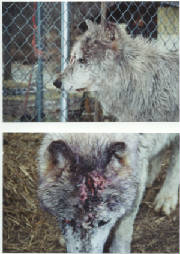
|
| Photo courtesy Wolf Creek Habitat originally placed in my guide |
28) How can I tell the difference between a wolf's tracks
and a dogs tracks?
A) It is not any one single thing to help determine the difference between
a wolf's tracks and a dog's tracks. A few questions to ask are
1) Area: are you remote enough that
there is not commonly dogs around that area
2) Size of tracks: wolf tracks
are typically just over 4 inches (4.25) to as large as near 6 inches (5 3/4") for the front prints, with the back feet
always being a bit smaller. Width wise wolf tracks are in the 3 1/2-4 inch range. Place your hand down alongside the track
is it fairly close to your hand size?
Dog tracks even a medium to larger (sized), typically
have a 3-4 inch track, with the latter being a larger sized dog, for example I owned a 75 pound dog that had a 3 1/2 inch
track, even though he was a fairly tall big dog. This does not mean a very large breed of dog cannot have a 4 1/2 inch track.
Dogs have rounder feet than wolves, wolves have two very large top protruding front toes (which helps elongate the track/larger)
3) Are the prints single track?
these things must all be grouped together as it is
not one single thing to help ID any wild animal track.
Coyote tracks will also appear as
single tracking, but size wise are approx 2 1/2 inches long, quite a bit smaller than any wolf's. Coyote, wolf, and dog
tracks the claws can show or be seen through a dragging motion. Wolf tracks and coyote tracks are symmetrical (click on linked words for detailed description of the word)
fox tracks the claws will be harder to see (look closely.) Fox tracks can vary in
size depending on the region/type of fox. I recommend going to another page on this site www.wolfechovalley.com/wolfcountry.html for recommended track books.
| wolf track 4 inches wide and 5 inches in lenth |
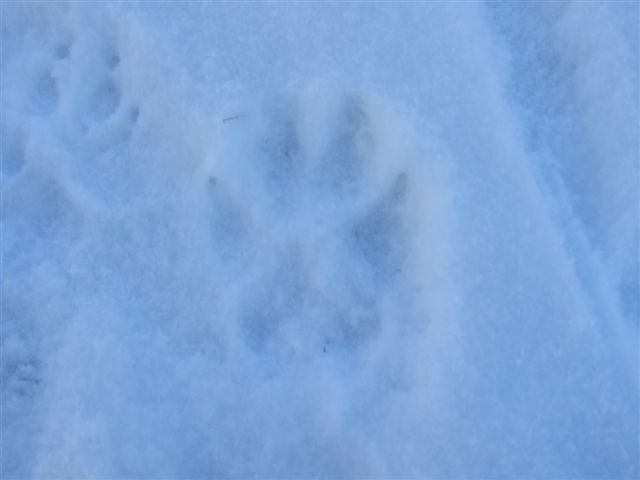
|
| wolf tracks |
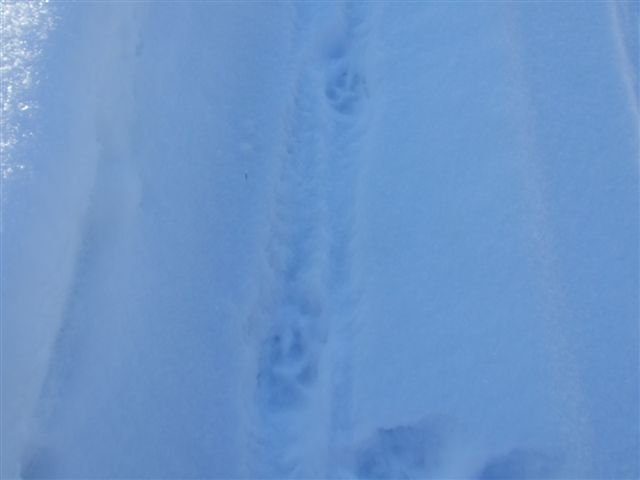
|
29) Is
there a test to distinguish between a pure wolf and dog? How closely related are wolves to dogs? A) There is new information coming to light all the time of the close relationship wolves and dogs share.
At one point wolves and dogs were scientifically classified as two separate and distinct species of canine. The wolf
*Canis lupus* The Dog *Canis familiaris*. But in 1993 the Smithsonian Institute reclassified the domestic dog
taxonomically to reflect that wolves and dogs are from the same genus *family*, dogs are now known as *canis lupus familiaris*.
they state there is no DNA test to distinguish
wolves and dogs, dogs and wolfdogs, this was true as little as a few years ago, but it has been worked on for many
years and it is said via officials to now be possible
for tests to determine wolf in the dog. DNA tests on
are said to conclusively
determine between a dog and wolf, and a dog that has wolf in it. However it also begs the question as to just
how many base lines were studied in-depth. Do they have verifiable untainted base lines on every single breed
of dog in the world, and they are CONCLUSIVE? Do they have baselines of every single subspecies that has existed. I
would like to know if pure wolves carry *any* dog *markers*, and if this is found in say a wild roaming wolf
how they know this is not a part of what a wolf is and the marker was just not seen before due to limited
base lines for a particular sub-species, instead of automatically ruling the animal a wolfhybrid. I believe
in the science though and the science is REAL, however I don't always believe in the humans conducting that science,
as the science can be made to (fit the story.) I would like to see ALL the info. FREELY distributed.
Combined use of maternal, paternal and bi-parental
genetic markers for the identification of wolf-dog hybrids
The identification of hybrids is often a subject of primary concern
for the development of conservation and management strategies, but can be difficult when the hybridizing species are closely
related and do not possess diagnostic genetic markers. However, the combined use of mitochondrial DNA (mtDNA), autosomal and
Y chromosome genetic markers may allow the identification of hybrids and of the direction of hybridization. We used these
three types of markers to genetically characterize one possible wolf-dog hybrid in the endangered Scandinavian wolf population.
We first characterized the variability of mtDNA and Y chromosome markers in Scandinavian wolves as well as in neighboring
wolf populations and in dogs. While the mtDNA data suggested that the target sample could correspond to a wolf, its Y chromosome
type had not been observed before in Scandinavian wolves. We compared the genotype of the target sample at 18 autosomal microsatellite
markers with those expected in pure specimens and in hybrids using assignment tests. The combined results led to the conclusion
that the animal was a hybrid between a Scandinavian female wolf and a male dog. This finding confirms that inter-specific
hybridization between wolves and dogs can occur in natural wolf populations. A possible correlation between hybridization
and wolf population density and disturbance deserves further research. Heredity (2003) 90,
17-24. doi:10.1038/sj.hdy.6800175
~From MT Fish Wildlife & Parks
Wednesday, February 28, 2007
Domestic Wolf Responsible For Eastern
Montana Livestock Killings
Montana Fish,Wildlife & Parks learned today that the animal likely responsible for
a rash of eastern Montana livestock depredations last year was a domestic wolf, and not a wild Rocky Mountain
gray wolf.
The domestic wolf was suspected of killing more than 120 sheep and injuring a number of others
in eight different incidents in Dawson, Garfield and McCone counties from December 2005 and July 2006.
Although there
was some question early on about the animal’s genetic origin, FWP authorized affected landowners, USDA
Wildlife Services, and county predator-control specialists to kill the elusive animal. The animal was eventually killed by
federal agents on a Garfield County ranch east of Jordan last November.
To determine the animal’s origin and
genetic make up, samples were sent to the U.S. Fish and Wildlife Service National
Forensics Laboratory in Ashland, Oregon and to Dr. Bob Wayne’s genetics laboratory at UCLA’s Department of Ecology
and Evolutionary Biology in California.
Both labs determined independently that the
animal did not come from, nor was the animal’s genetics consistent with, wild free-ranging wolf populations in the Northern
Rockies, the Midwest, or Canada.
The genetic experts concluded
that the animal was a product of human-manipulated breeding in a domestic, captive situation.
"This
individual displays classic characteristics of being a domestic wolf," said Dyan Straughan, a forensic
scientist at the National Forensics Laboratory. "The hodgepodge mixture of DNA found does not occur naturally in wild
wolves in North America."
Lab results revealed DNA from three different sources, including maternal DNA from the Great
Lakes region, paternal DNA from the lower 48 states, and DNA closely related to wolves in Alaska. It is the
presence of all three DNA sources that preclude the possibility of the animal being a wild wolf.
The carcass’s
orange color, small foot size and general appearance also did not match typical wild, free ranging wolves. Other physical
evidence also suggest that the animal had been in captivity, including long claws, tartar stains on the teeth, and teeth that
were in relatively good condition compared to most four-year-old wild wolves.
"The National Forensics Laboratory
in particular has an extensive DNA library of wild North American wolves, captive domestic wolves, and
wolf-dog hybrids for comparison," said Carolyn Sime, FWP’s wolf program coordinator. "They have run over
a thousand samples and maintain the most extensive reference collection anywhere so we have confidence in their results."
Montana law requires that any captive, domestic, or hybrid wolf that is more than half wolf to be permanently
tattooed and registered with FWP. State law also requires that any escape, release, transfer, or other change in disposition
of such animals be reported to FWP. Financial liability for property damage caused by these animals is the responsibility
of the owner.
Sime said no one knows where the animal came from, how it arrived in eastern Montana,
or when it arrived. "There were no permanent markings or tattoos on this animal, which are required by law."
Anyone
with information on this domestic wolf is urged to call Montana’s violation hotline at 1-800-TIP-MONT (1-800-847-6668).
HYBRID PIPESTEM PUPS
HUMANELY EUTHANIZED
Contacts: VICTORIA FOX, 505-248-6455 OR ELIZABETH
SLOWN, 505-248-6909
The offspring born to the female Mexican wolf of the Pipestem pair have been confirmed as hybrids.
The genetic analysis revealed that (1) F628 is the mother of the pups, (2) M190 is not the father, and (3) the pups are not
Mexican wolves. The genetic analysis could not determine for certain what the father is. However, the
results indicate that the father is most likely a domestic or feral dog, or wolf x dog hybrid. The
phenotypic traits of the pups supports the finding that these pups resulted from such a cross-breeding.
The whole Pipestem group, which included the adult male, adult female and offspring, were removed
from the wild in May of this year at the request of a private landowner on whose property the wolves had been frequenting
and killing livestock. They were all held in captivity at Sevilleta National Wildlife Refuge where the adults remain. In keeping
with the Service’s Final Rule for managing the Mexican wolf reintroduction and recovery program, these offspring have
been humanely euthanized.
Section (3) (x) of our current Final Rule for the reintroduction of Mexican wolves into the Blue
Range of Arizona and New Mexico (50 CFR section 17.84(k)) states:
"As determined by the Service to be appropriate, the Service or any agent so authorized by the
Service, may capture, kill, subject to genetic testing, place in captivity, euthanize, or return to the wild (if found to
be a pure Mexican wolf) any feral wolf-like animal, feral wolf hybrid, or feral dog found within the Mexican Wolf Experimental
Population Area that shows physical or behavioral evidence of hybridization with other canids, such as domestic dogs or coyotes;
being an animal raised in captivity, other than as part of a Service-approved wolf recovery program; or being socialized or
habituated to humans."
3) DNR: Animal killed
by hunter near Oshkosh was gray wolf
The Northwestern
Laboratory tests by the Wisconsin Department of Natural Resources
determined an animal shot by a hunter in Winnebago County was a wolf and not a dog-wolf hybrid, the DNR announced today.
The wolf was killed in the town of Nekimi on Dec. 29 by an archery hunter,
after having been spotted in Oshkosh and the surrounding area in previous days. Although initial inspection of the animal
indicated it was not a coyote, officials needed to wait for DNR to determine whether it was a wolf or a hybrid.
DNR
officials have decided to levy the minimum fine of $306.30 against the hunter, who is from Brandon, but will not seek to revoke
his license. In a statement, DNR officials said the hunter was cooperative and did not attempt to hide or conceal the incident,
which would have resulted in more severe penalities.
“It is a difficult enforcement decision when a person takes
responsibility for their actions and self reports a violation,” a press release states. “The shooter has been
issued a Natural Resource Citation for taking a protected species. Proper identification of the target is one of the primary
firearm safety tips and based on the investigation and circumstances the hunter should have known the animal was not a legal
target (coyote).”
Winnebago County is not traditional or normal wolf range, but statewide DNR Offices often received
calls of possible wolf sighting outside normal wolf range. It is not uncommon for young wolves to roam hundreds of miles outside
their normal range. The known wolf packs closest to Winnebago County are the Menomonie Reservation to the north and Wisconsin
Rapid area to the west. The Gray Wolf was removed from the Endangered and Threatened species list in March of 2007.
http://www.thenorthwestern.com/apps/pbcs.dll/article?AID=/20080215/OSH/80215061/1987
NEWS RELEASE
WASHINGTON DEPARTMENT OF FISH AND WILDLIFE
600
Capitol Way North, Olympia, Washington 98501-1091
Internet Address: http://wdfw.wa.gov
July 17, 2008
Contact: Madonna Luers, (509) 892-7853
or Kevin Robinette, (509) 892-7859
Road-killed
canine verified as wolf
New genetic tests have verified that a canine found
dead on a road northwest of Spokane last month was a pure gray wolf.
A second road-killed
animal found slightly farther west about two weeks later was a wolf-dog hybrid, genetic tests determined.
The
Washington Department of Fish and Wildlife (WDFW) sent tissue samples from both road-killed animals to the University of California-Los
Angeles Conservation Genetics Resource Center to determine whether they were wolves. The California lab recently developed
DNA-sequencing techniques to genetically distinguish gray wolves (Canis lupus) from wolf-dog hybrids or domestic dogs (Canis
lupus familiaris). The genetic make-up of wolves and dogs is so similar that previous tests were unable to distinguish the
two. Wolf and dog DNA differs by only two-tenths of one percent (0.2%).
These new genetic tests promise to greatly
assist us in the future management of gray wolves, said WDFW Director Jeff Koenings, adding that WDFW's genetics laboratory
is investigating adopting the same genetic-testing approach in the future to support the state's upcoming Wolf Conservation
and Management Plan.
The wolf carcass was discovered June 5 by a Washington Department of Transportation (DOT) crew
along State Route 291 near Tum Tum in Stevens County, about 25 miles northwest of Spokane. DOT staff contacted WDFW to retrieve
the carcass.
The wolf-dog hybrid was struck by a car June 21 on State Route 25 north of Davenport in Lincoln County,
about 40 miles northwest of Spokane. The driver contacted the county sheriff, who contacted WDFW.
Other genetic tests
on the animal killed on State Route 291 showed its DNA was similar to that from wolves in northwest Montana and southern British
Columbia.
Gray wolves last spring were removed from federal endangered species list in the eastern third of Washington,
as part of a recovered Rocky Mountain wolf population in Idaho, Montana and Wyoming. The wolf de-listing is being challenged
in federal district court by conservation groups. Gray wolves remain listed by the state as an endangered species throughout
Washington.
WDFW Endangered Species Program Manager Harriet Allen said verification of a road-killed wolf is not surprising
because individual wolves are sighted periodically in northeast Washington.
"We expect wolves from Idaho, Montana,
eastern Oregon or Canada to disperse to Washington," Allen said.
Verification of the wolf-dog hybrid is also not surprising,
Allen said.
"Unfortunately, some people attempt to raise wolves and wolf-dog hybrids in captivity," Allen said. "Wolf-dog
hybrids can be dangerous because they lack the shyness of wild wolves, but they have the physical strength and predatory instincts
of wild animals."
Wolf-dog hybrids complicate gray wolf management in a number of ways, including attacking livestock
in incidents that are mistakenly blamed on wild wolves.
Pet wolves are prohibited by state law (RCW 16.30.030), although
wolf-dog hybrids are excluded from that ban and remain regulated as domestic dogs. Most Washington counties have dog-control
regulations and some counties and cities prohibit wolf-dog hybrid ownership because of potential safety problems.
WDFW
is drafting a Wolf Conservation and Management Plan, with the help of a 17-member citizen working group. The draft plan is
available at http://wdfw.wa.gov/wlm/diversty/soc/gray_wolf/. After scientific peer review this year, a final draft plan will be circulated for public comment
early next year.
No established wolf breeding pairs or packs have been documented in Washington since the 1930s, although
WDFW and federal officials are currently working to locate and radio-collar wolves in Okanogan County, where recent howling
surveys indicate a pack may exist.
Reports of possible wolf sightings or activity can be made to a toll-free wolf reporting
hotline at 1-888-584-9038.
http://blogs.thenewstribune.com/politics/2008/07/17/wolf_dog_hybrid_killed_near_spokane_i_se
30) Why do wolves howl? A)
Wolves love to howl, they howl to reunite their pack members when separated, they howl when mourning the loss of a
pack member, they howl when excited, they howl prior to a hunt and after eating in bonding sessions, they howl to alert other
wolves (wolf packs) they are in the area, they howl when pups are born within the pack, and they howl just because they feel
like it. I am sure there are reasons wolvs howl, that humans are not even aware of.
31) Does
a full moon make wolves howl? A) A full moon in
and of itself, do not make wolves howl. BUT... a full moon helps to light up the hunting grounds,
for wolves, and other creatures in the wild, and this does seem to aid in, and incite a bit more activity and excitement
in general, as well as a bit more frequent howling in wolves. Through observation of wild wolves howling a
bit more than average on a full moon night, people that lived amongst wild wolves in olden days, would have made this
connection , which eventually could have turned into more legendary old wives tales, and myths of today. I know
here without failure, on every full moon the wolves will howl consistently all night long, off and on.
32) How big is
a wolfs territory? A) A wolf packs territory can be as small as 5 miles, all the way up to a
range of any number of hundreds even thousands of miles, it all depends if they have all the necessary resources (food/mates
to choose from/safety from their only known predator humans/within that range chosen, how large the wolf pack is, and the
impact the size of the pack will make on the land and food resources in the range/size they choose to settle into.
33) how far do wolves travel
a day? A)
Wolves in search of food can travel daily distances, of a few miles all the way to 30.
They have been known to travel hundreds of miles in a day however when in search of mates/new pack members.
|
